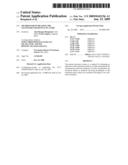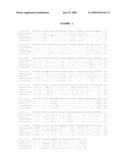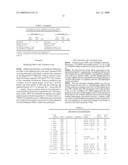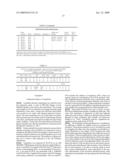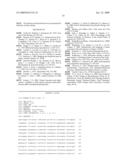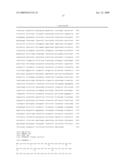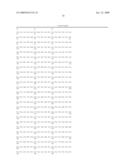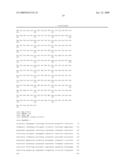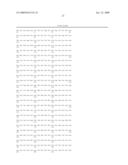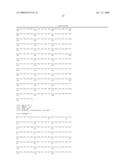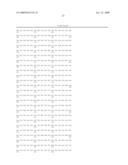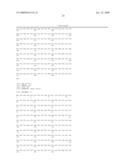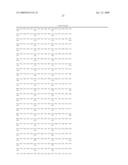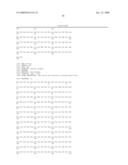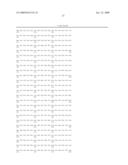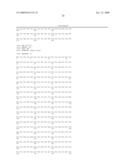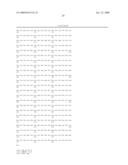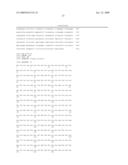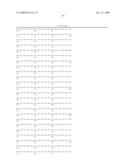Patent application title: METHOD FOR INCREASING THE SALTWATER TOLERANCE OF A FISH
Inventors:
Aina Haugen Rengmark (Oslo, NO)
Frode Lingaas (Fagernes, NO)
Assignees:
Norwegian School of Veterinary School
IPC8 Class: AC12N1500FI
USPC Class:
800 22
Class name: Multicellular living organisms and unmodified parts thereof and related processes method of making a transgenic nonhuman animal involving breeding to produce a double transgenic nonhuman animal
Publication date: 2009-06-25
Patent application number: 20090165156
Claims:
1. A method of determining the saltwater tolerance of a fish, the method
comprising determining the status of a biomarker in a fish, wherein the
biomarker is one which is correlated with high or low saltwater tolerance
of the fish, and wherein the presence or absence of said biomarker is
indicative of the saltwater tolerance of the fish.
2. The method of claim 1, wherein the biomarker is transferrin DNA, RNA or polypeptide, the glycosylation pattern of the transferrin polypeptide, or the iron-binding ability of the transferrin polypeptide.
3. The method of claim 2, wherein the biomarker is a variation of the nucleotide sequence of the DNA in or near the transferrin gene, a variation of the nucleotide sequence of the transferrin RNA, a variation of the amino acid sequence of the transferrin polypeptide.
4. The method of claim 3, wherein the biomarker is one or more single nucleotide polymorphisms (SNP), a haplotype, a microsatellite, an alternatively-spliced RNA product, or a polypeptide epitope.
5. The method of claim 4, wherein the biomarker is one or more single nucleotide polymorphism (SNP), and wherein the one or more SNP is at a position in the transferrin gene selected from the group consisting of: ex7 (bp2968), ex8-1 (bp3190), ex8-2 (bp3224), ex8-3 (bp3229), intr8 (bp3330), ex14 (bp5368), intr14-1 (bp5437), intr14-2 (bp5462-3), intr14-3 (bp5467), ex15-1 (bp5521), ex15-2 (bp5598), intr15-1 (bp5689), intr15-2 (bp6530), ex16-1 (bp6549), ex16-2 (bp6562-4), ex16-3 (bp6659), ex16-4 (bp6685-8), ex16-5 (bp6697-9), ex16-6 (bp6729), ex16-7 (bp6733), ex16-8 (bp6736), intr16-1 (bp6769), intr16-2 (bp6777), intr16-3 (bp6780), intr16-4 (bp6785), intr16-5 (bp6848).
6. The method of claim 3, wherein a DNA, RNA or polypeptide sample is obtained from the fish, wherein the biomarker is correlated with high saltwater tolerance of the fish, and wherein the presence of said biomarker in the sample is indicative of high saltwater tolerance of the fish.
7. The method of claim 6, wherein the DNA in the sample carrying the variation of the nucleotide sequence in or near the transferrin gene is amplified.
8. The method of claim 1 further comprising:(a) obtaining a sample from the fish comprising transferrin polypeptide,(b) contacting the sample with an antibody that specifically binds to a transferrin polypeptide comprising one or more of the amino acid changes of haplotype 2, selected from the group consisting of Ala256 (A)→Gly256 (G), Ala295 (A)→Thr295 (T), Arg306 (R)→Lys306 (K), Leu308 (L)→Val308 (V), Val545 (V)→Ile545 (I), Ala593 (A)→Val593 (V), Ala617 (A)→Thr617 (T), Ala622 (A)→Ser622 (S), Glu654 (E)→Gly654 (G), Glu663 (E) Ala664 (A)→Ile663 (I) Ser664 (S), Asp667 (D)→Thr667 (T), Asp677 (D)→Glu677 (E), Ala679 (A)→Thr679 (T), and Ser680 (S)→Pro680 (P),(c) detecting the binding of the antibody,wherein binding of the antibody indicates the saltwater tolerance of the fish.
9. A method for increasing the saltwater tolerance of a fish, the method comprising integrating a transferrin gene stably into the genome of the fish in a position such that the transferrin gene is expressed in some or all tissues of the fish, wherein expression of transferrin increases the saltwater tolerance of the fish.
10. The method of claim 9, further comprising:(a) selecting a male fish from the population; and(b) obtaining sperm from the male fish.
11. The method of claim 9, further comprising:(a) selecting a female fish from the population; and(b) obtaining eggs from the female fish.
12. The method of claim 9, further comprising:breeding the saltwater tolerant fish of claim 8 with a fish of the opposite sex in order to produce progeny fish.
13. The method of claim 9, further comprising:(a) obtaining gametes from the saltwater tolerant fish of claim 8,(b) combining the gametes from the saltwater tolerant fish with gametes from a second fish of the opposite sex in order to produce progeny fish(c) selecting progeny which have high saltwater tolerance.
14. The method of claim 9, wherein the fish is a teleost or bony fish.
15. The method of claim 9, wherein the fish is a Cichlidae, Salmonidae, Cyprinidae or Gadidae.
16. An isolated antibody, wherein the antibody specifically binds to a transferrin polypeptide comprising one or more of the amino acid changes of haplotype 2, selected from the group consisting of Ala256 (A)→Gly256 (G), Ala295 (A)→Thr295 (T), Arg306 (R)→Lys306 (K), Leu308 (L)→Val308 (V), Val545 (V)→Ile545 (I), Ala593 (A)→Val593 (V), Ala617 (A)→Thr617 (T), Ala622 (A)→Ser622 (S), Glu654 (E)→Gly654 (G), Glu663 (E) Ala664 (A)→Ile663 (I) Ser664 (S), Asp667 (D)→Thr667 (T), Asp677 (D)→Glu677 (E), Ala679 (A)→Thr679 (T), and Ser680 (S)→Pro680 (P).
17. An isolated polypeptide comprising the amino acid sequence of SEQ ID NO: 15.
18. An isolated nucleic acid molecule encoding the polypeptide of claim 17 or comprising the nucleic acid sequence of SEQ ID NO: 14.
19. A vector or plasmid comprising the nucleic acid molecule of claim 18.
Description:
RELATED APPLICATIONS
[0001]This applications claims priority under 35 U.S.C. §119(e) from U.S. provisional application Ser. No. 61/000,324, filed Oct. 24, 2007, and is a continuation-in-part of PCT application PCT/GB2007/002291, filed Jun. 20, 2007, which claims priority from Norwegian application No. 20062887, filed Jun. 20, 2006, the entire contents of each of which are incorporated herein by reference.
FIELD OF THE INVENTION
[0002]The present invention relates to a method for obtaining an indication of the saltwater tolerance of a fish, and methods for increasing the saltwater tolerance of a fish.
BACKGROUND OF THE INVENTION
[0003]Tilapias belong to a genus of fish within the cichlid family and are becoming the world's leading aquaculture species, with the Nile tilapia (Oreochromis niloticus) at the forefront (Bentsen et al., 1998; Kocher, 2002; Roderick, 1999; Trewavas, 1983).
[0004]Tilapias are easily raised and harvested, may be fed a diet of abundant algae and zooplankton. The commercially most important species and strains are predominantly found in fresh water. Since the availability of freshwater is severely limited in many countries, the exploitation of brackish water areas and other facilities, typically abandoned coastal shrimp farms, may present an opportunity to expand the tilapia aquaculture industry with only modest investments (Yi et al., 2002). However, such development requires a tilapia that tolerates saltwater without reduction in growth performance and health. Increased knowledge of genes involved in saltwater tolerance may facilitate selection for this trait.
[0005]The genus Oreochromis tolerates brackish water, but with a great variation among the species. Oreochromis mossambicus and O. aureus (blue tilapia) show a higher degree of salt tolerance than the Nile tilapia (Avella et al., 1993; Cataldi et al., 1988; Doudet, 1992), indicating that salt tolerance may be controlled by genetic factors.
[0006]WO03/018845 describes a method for identifying fast-growing fish in different salinities using a selection method based on their prolactin-1 genotype.
SUMMARY OF THE INVENTION
[0007]The present invention relates to a method for obtaining an indication of the saltwater tolerance of a fish, and methods for increasing the saltwater tolerance of a fish. It has now been found that a number of biological markers in the transferrin gene are correlated with saltwater tolerance.
[0008]In some embodiments, methods of determining the saltwater tolerance of a fish are provided, the method comprising determining the status of a biomarker in a fish, wherein the biomarker is one which is correlated with high or low saltwater tolerance of the fish, and wherein the presence or absence of said biomarker is indicative of the saltwater tolerance of the fish.
[0009]In certain embodiments, the biomarker is transferrin DNA, RNA or polypeptide, the glycosylation pattern of the transferrin polypeptide, or the iron-binding ability of the transferrin polypeptide.
[0010]In certain embodiments, the biomarker is a variation of the nucleotide sequence of the DNA in or near the transferrin gene, a variation of the nucleotide sequence of the transferrin RNA, a variation of the amino acid sequence of the transferrin polypeptide.
[0011]In certain embodiments, the biomarker is one or more single nucleotide polymorphisms (SNP), a haplotype, a microsatellite, an alternatively-spliced RNA product, or a polypeptide epitope.
[0012]In certain embodiments, the biomarker is one or more single nucleotide polymorphism (SNP), and wherein the one or more SNP is at a position in the transferrin gene selected from the group consisting of: ex7 (bp2968), ex8-1 (bp3190), ex8-2 (bp3224), ex8-3 (bp3229), intr8 (bp3330), ex14 (bp5368), intr14-1 (bp5437), intr14-2 (bp5462-3), intr14-3 (bp5467), ex15-1 (bp5521), ex15-2 (bp5598), intr15-1 (bp5689), intr15-2 (bp6530), ex16-1 (bp6549), ex16-2 (bp6562-4), ex16-3 (bp6659), ex16-4 (bp6685-8), ex16-5 (bp6697-9), ex16-6 (bp6729), ex16-7 (bp6733), ex16-8 (bp6736), intr16-1 (bp6769), intr16-2 (bp6777), intr16-3 (bp6780), intr16-4 (bp6785), intr16-5 (bp6848).
[0013]In some embodiments, a DNA, RNA or polypeptide sample is obtained from the fish, wherein the biomarker is correlated with high saltwater tolerance of the fish, and wherein the presence of said biomarker in the sample is indicative of high saltwater tolerance of the fish.
[0014]In certain embodiments, the DNA in the sample carrying the variation of the nucleotide sequence in or near the transferrin gene is amplified.
[0015]In some embodiments, methods of determining the saltwater tolerance of a fish are provided, the method comprising (a) obtaining a sample from the fish comprising transferrin polypeptide, (b) contacting the sample with an antibody that specifically binds to a transferrin polypeptide comprising one or more of the amino acid changes of haplotype 2, selected from the group consisting of Ala256 (A)→Gly256 (G), Ala295 (A)→Thr295 (T), Arg306 (R)→Lys306 (K), Leu308 (L)→Val308 (V), Val545 (V)→Ile545 (I), Ala593 (A)→Val593 (V), Ala617 (A)→Thr617 (T), Ala622 (A)→Ser622 (S), Glu654 (E)→Gly654 (G), Glu663 (E) Ala664 (A)→Ile663 (I) Ser664 (S), Asp667 (D)→Thr667 (T), Asp677 (D)→Glu677 (E), Ala679 (A)→Thr679 (T), and Ser680 (S)→Pro680 (P), and (c) detecting the binding of the antibody, wherein binding of the antibody indicates the saltwater tolerance of the fish.
[0016]In some embodiments, methods for increasing the saltwater tolerance of a fish are provided, the method comprising integrating a transferrin gene stably into the genome of the fish in a position such that the transferrin gene is expressed in some or all tissues of the fish, wherein expression of transferrin increases the saltwater tolerance of the fish.
[0017]In certain embodiments, the methods further comprise selecting a male fish from the population and obtaining sperm from the male fish.
[0018]In certain embodiments, the methods further comprise selecting a female fish from the population and obtaining eggs from the female fish.
[0019]In certain embodiments, the methods further comprise breeding the saltwater tolerant fish of any of the preceding methods with a fish of the opposite sex in order to produce progeny fish.
[0020]In certain embodiments, the methods further comprise obtaining gametes from the saltwater tolerant fish of any of the preceding methods, combining the gametes from the saltwater tolerant fish with gametes from a second fish of the opposite sex in order to produce progeny fish and selecting progeny which have high saltwater tolerance.
[0021]In certain embodiments, the fish is a teleost or bony fish.
[0022]In certain embodiments, the fish is a Cichlidae, Salmonidae, Cyprinidae or Gadidae.
[0023]In some embodiments, isolated antibodies are provided, wherein the antibody specifically binds to a transferrin polypeptide comprising one or more of the amino acid changes of haplotype 2, selected from the group consisting of Ala256 (A)→Gly256 (G), Ala295 (A)→Thr295 (T), Arg306 (R)→Lys306 (K), Leu308 (L)→Val308 (V), Val545 (V)→Ile545 (I), Ala593 (A)→Val593 (V), Ala617 (A)→Thr617 (T), Ala622 (A)→Ser622 (S), Glu654 (E)→Gly654 (G), Glu663 (E) Ala664 (A)→Ile663 (I) Ser664 (S), Asp667 (D)→Thr667 (T), Asp677 (D)→Glu677 (E), Ala679 (A)→Thr679 (T), and Ser680 (S)→Pro680 (P).
[0024]In some embodiments, isolated polypeptides comprising the amino acid sequence of SEQ ID NO: 15 are provided.
[0025]In certain embodiments, isolated nucleic acid molecules are provided, encoding the polypeptide of SEQ ID NO: 15 or comprising the nucleic acid sequence of SEQ ID NO: 14.
[0026]In certain embodiments, vectors or plasmids are provided comprising the nucleic acid molecules encoding the polypeptides of SEQ ID NO: 15 or comprising the nucleic acid molecules comprising the nucleic acid sequence of SEQ ID NO: 14.
[0027]In some embodiments, methods of obtaining an indication of the saltwater tolerance of a fish are provided, the methods comprising establishing the presence or absence of a biomarker in or near the transferrin gene of the fish, in the transferrin RNA or in the transferrin polypeptide of the fish, wherein the biomarker is one which is correlated with high or low saltwater tolerance of the fish.
[0028]In some embodiments, the biomarker is DNA sequence information, one or more single nucleotide polymorphisms (SNPs), haplotypes, microsatellites, RNA-variants, including alternatively-spliced products, amino acid sequence information, polypeptide epitopes, glycosylation patterns or the iron-binding ability of the transferrin polypeptide.
[0029]In some embodiments, methods of obtaining an indication of the saltwater tolerance of a fish are provided, the methods comprising establishing the presence or absence in a DNA sample obtained from the fish of a biomarker in or near the transferrin gene wherein the biomarker is one which is correlated with high saltwater tolerance of the fish and wherein the presence of said biomarker in the DNA sample is indicative of high saltwater tolerance of the fish.
[0030]In some embodiments, methods of obtaining an indication of the saltwater tolerance of a fish are provided, the method comprising establishing the presence or absence in a DNA sample obtained from the fish of at least one single nucleotide polymorphism (SNP) in the transferrin gene, wherein at least one of the SNPs is at a position in the transferrin gene which corresponds to a position of a SNP shown in Table 2 and/or Table 3.
[0031]In some embodiments, methods of obtaining an indication of the saltwater tolerance of a fish are provided, the method comprising establishing the presence or absence in a biological sample obtained from a transferrin-expressing tissue from the fish of a biomarker in the transferrin RNA wherein the biomarker is one which is correlated with high salt water tolerance in the fish, wherein the presence of said biomarker in the biological sample is indicative of high saltwater tolerance of the fish.
[0032]In some embodiments, methods of obtaining an indication of the saltwater tolerance of a fish are provided, the method comprising establishing the presence or absence in a biological sample obtained from a transferrin-expressing tissue from the fish of at least one single nucleotide polymorphism (SNP) in the transferrin RNA, wherein at least one of the SNPs is at a position in the transferrin RNA which corresponds to a position of a SNP shown in Table 2 and/or Table 3.
[0033]In certain embodiments, all preceding methods are provided, further comprising the step of amplifying the region of the fish DNA which includes the biomarker in question.
[0034]In some embodiments, kits comprising at least one nucleic acid primer are provided, wherein the nucleic acid primer is capable of hybridising under high stringency conditions to the coding or non-coding strand of a region of DNA in or near the transferrin gene and which can be used in an exponential amplification reaction to amplify a region of DNA which comprises at least one of the microsatellites given in Table 2 or 3, or at least one of the SNPs in Table 2 or 3, or corresponding SNPs or microsatellites in the fish in question.
[0035]In some embodiments, methods of obtaining an indication of the saltwater tolerance of a fish are provided, the method comprising determining the presence in the fish of a transferrin polypeptide isoform which is associated with high salt water tolerance.
[0036]In some embodiments, methods of obtaining an indication of the saltwater tolerance of a fish are provided, the method comprising detecting whether a first antibody binds to a transferrin-containing sample obtained from the fish, wherein said first antibody is an antibody which binds specifically to a transferrin polypeptide which has one or more of the amino acid changes of Haplotype 2 at the positions shown in Table 2 or Table 3 or at corresponding positions in the transferrin polypeptide of the said fish, wherein the antibody does not bind to a transferrin polypeptide which does not have any of the amino acid changes of Haplotype 2 at the positions shown in Table 2 or Table 3 or at corresponding positions in the transferrin polypeptide of the said fish, and/or detecting whether a second antibody binds to a transferrin-containing sample obtained from the fish, wherein said second antibody is an antibody which binds specifically to a transferrin polypeptide which does not have any of the amino acid changes of Haplotype 2 at the positions shown in Table 2 or Table 3 or at corresponding positions in the transferrin polypeptide of the said fish, wherein the second antibody does not bind to a transferrin polypeptide which has one or more of the amino acid changes of Haplotype 2 at the positions shown in Table 2 or Table 3 or at corresponding positions in the transferrin polypeptide of the said fish.
[0037]In some embodiments, antibodies are provided, wherein the antibodies bind specifically to a transferrin polypeptide which has one or more of the amino acid changes of Haplotype 2 at the positions shown in Table 2 or Table 3 or at corresponding positions in the transferrin polypeptide of the said fish, wherein the antibodies do not bind to a transferrin polypeptide which does not have any of the amino acid changes of Haplotype 2 at the positions shown in Table 2 or Table 3 or at corresponding positions in the transferrin polypeptide of the said fish; or antibodies that bind specifically to a transferrin polypeptide which does not have any of the amino acid changes of Haplotype 2 at the positions shown in Table 2 or Table 3 or at corresponding positions in the transferrin polypeptide of the said fish, wherein the antibodies do not bind to a transferrin polypeptide which has one or more of the amino acid changes of Haplotype 2 at the positions shown in Table 2 or Table 3 or at corresponding positions in the transferrin polypeptide of the said fish.
[0038]In some embodiments, kits are provided comprising an antibody which binds specifically to a transferrin polypeptide which has one or more of the amino acid changes of Haplotype 2 at the positions shown in Table 2 or Table 3, wherein the antibody does not bind to a transferrin polypeptide which does not have any of the amino acid changes of Haplotype 2 at the positions shown in Table 2 or Table 3, and/or an antibody which binds specifically to a transferrin polypeptide which does not have any of the amino acid changes of Haplotype 2 at the positions shown in Table 2 or Table 3, wherein the antibody does not bind to a transferrin polypeptide which has one or more of the amino acid changes of Haplotype 2 at the positions shown in Table 2 or Table 3, and optionally, appropriate instructions for use.
[0039]In some embodiments, methods of finding a biomarker which is indicative of saltwater tolerance in a fish are provided, the methods comprising determining the presence in or near the transferrin gene of a biomarker which is present in fish which are saltwater tolerant but is not present in fish which are not saltwater tolerant.
[0040]In some embodiments, methods of finding a biomarker other than transferrin which is indicative of saltwater tolerance in a fish are provided, the methods comprising providing a population of fish which have a first biomarker in or near the transferrin gene of the fish, wherein the first biomarker is one which is correlated with saltwater tolerance of the fish, establishing the presence in a DNA, RNA or polypeptide sample of the fish of a second biomarker which is correlated with the presence of the first biomarker, wherein the second biomarker is not in or near the transferrin gene, in the transferrin RNA or in the transferrin polypeptide, wherein the second biomarker is one which is indicative of salt tolerance of the fish.
[0041]In some embodiments, methods of producing a fish are provided, the methods comprising selecting a first fish whose saltwater tolerance has been determined by any suitable method described herein, and breeding said first fish with a fish of the opposite sex in order to produce progeny fish.
[0042]In some embodiments, methods of producing a fish are provided, the methods comprising determining the saltwater tolerance of a first fish by any suitable method described herein, and breeding said first fish with a fish of the opposite sex in order to produce progeny fish.
[0043]In some embodiments, methods of producing a fish are provided, the methods comprising selecting a first fish whose saltwater tolerance has been determined by any suitable method described herein, obtaining gametes from the first fish, and combining the gametes from the first fish with gametes from a second fish of the opposite sex in order to produce progeny fish.
[0044]In some embodiments, methods of producing a fish are provided, the methods comprising determining the saltwater tolerance of a first fish by any suitable method described herein, obtaining gametes from the first fish, combining the gametes from the first fish with gametes from a second fish of the opposite sex in order to produce progeny fish.
[0045]In some embodiments, methods of producing a fish are provided, the methods comprising determining the saltwater tolerance of a population of fish by any suitable method described herein, selecting two fish from the population, wherein the two fish are of opposite sex and both have high saltwater tolerance, breeding the two fish of opposite sex in order to produce progeny fish, and selecting progeny which have high saltwater tolerance.
[0046]In some embodiments, methods of producing a transgenic fish are provided, the methods comprising integrating a transferrin gene stably into the genome of the fish in a position such that the transferrin gene is expressed in some or all tissues of the fish.
[0047]In some embodiments, transgenic fish are provided, wherein the fish comprises a heterologous transferrin gene stably-integrated into its genome in a position such that the transferrin gene is expressed in some or all tissues of the fish.
[0048]In some embodiments, methods of increasing the saltwater tolerance of a fish are provided, comprising introducing into the fish an agent which increases the transferrin levels in the fish.
[0049]In some embodiments, methods of producing fish sperm are provided, comprising determining the saltwater tolerance of a population of fish by any suitable method described herein, selecting a male fish from the population; and obtaining sperm from the male fish.
[0050]In some embodiments, methods of producing fish eggs are provided, comprising determining the saltwater tolerance of a population of fish by any suitable method described herein, selecting a female fish from the population; and obtaining eggs from the female fish.
[0051]In some embodiments, any of the preceding methods are provided, wherein the fish is a teleost or bony fish.
[0052]In some embodiments, any of the preceding methods are provided, wherein the fish is a Cichlidae, Salmonidae, Cyprinidae or Gadidae.
[0053]In some embodiments, nucleic acid molecules whose nucleotide sequence comprises the sequence of SEQ ID NO: 14 or which encodes the amino acid sequence of SEQ ID NO: 15 are provided.
[0054]In certain embodiments, vectors or plasmids are provided comprising the nucleic acid molecules of SEQ ID NO: 14, or nucleic acid molecules that encode the amino acid sequence of SEQ ID NO: 15.
[0055]In certain embodiments, polypeptides are provided, wherein the amino acid sequence of the polypeptide consists of, or comprises the amino acid sequence of SEQ ID NO: 15.
BRIEF DESCRIPTION OF FIGURES
[0056]FIG. 1: Protein blast result (by Mega) with Nile tilapia, black and red sea bream, Japanese medaka and brown trout. The different symbols are as follows: identical amino acid (.), indels in sequence alignments (-) and stop codon (*). Marked in bold: conserved iron and anion binding residues (Lambert et al., 2005). The numbering are different than the notation used in Lambert et al. (2005) since the human protein was used as a model and the numbering there starts after the signal peptide cleavage at amino acid position 19 (similar for all the species included). The insertion of three amino acids in Nile tilapia only is underlined, so are the SNPs that cause amino acid change.
DESCRIPTION OF SEQUENCES
[0057]SEQ ID NO: 1 is the low saltwater tolerance form of the nucleotide sequence of the nile tilapia transferrin gene. [0058]SEQ ID NO: 2 is the low saltwater tolerance form of the amino acid sequence of the nile tilapia transferrin polypeptide. [0059]SEQ ID NO: 3 is the nucleotide sequence of the microsatellite region TF-A. [0060]SEQ ID NO: 4 is the nucleotide sequence of the microsatellite region TF-B. [0061]SEQ ID NO: 5 is the nucleotide sequence of the first PCR primer used to amplify microsatellite region TF-A. [0062]SEQ ID NO: 6 is the nucleotide sequence of the second PCR primer used to amplify microsatellite region TF-A. [0063]SEQ ID NO: 7 is the nucleotide sequence of the first PCR primer used to amplify microsatellite region TF-B. [0064]SEQ ID NO: 8 is the nucleotide sequence of the second PCR primer used to amplify microsatellite region TF-B. [0065]SEQ ID NO: 9 is the amino acid sequence of the Tilapia nilotica polypeptide, as given in FIG. 1. [0066]SEQ ID NO: 10 is the amino acid sequence of the Acanthopagrus schlegeli polypeptide, as given in FIG. 1.
[0067]SEQ ID NO: 11 is the amino acid sequence of the Salmo trutta polypeptide, as given in FIG. 1.
[0068]SEQ ID NO: 12 is the amino acid sequence of the Oryzias latipes polypeptide, as given in FIG. 1.
[0069]SEQ ID NO: 13 is the amino acid sequence of the Pagrus major polypeptide, as given in FIG. 1.
[0070]SEQ ID NO: 14 is the high saltwater tolerance form of the nucleotide sequence of the nile tilapia transferrin gene, i.e., SEQ ID NO: 1 with all of the SNPs of Haplotype 2 as shown in Tables 2 and 3. [0071]SEQ ID NO: 15 is the high saltwater tolerance form of the amino acid sequence of the nile tilapia transferrin polypeptide, i.e., SEQ ID NO: 2 with all of the SNPs of Haplotype 2 as shown in Tables 2 and 3.
DETAILED DESCRIPTION OF THE INVENTION
[0072]It has now been found that a number of biological markers in the transferrin gene are correlated with saltwater tolerance.
[0073]Transferrin is an iron binding glycoprotein. It is involved in several biological functions in a wide range of organisms, primarily as an iron transporter. Transferrin also has an important role in the immune system, since the binding of iron limits the availability of iron for replicating pathogens (Cnaani et al., 2002; Stafford and Belosevic, 2003). Transferrin (TF) is expressed primarily in liver and transported around the body in plasma supplying most body-tissues with iron, but is also expressed in several other organs (Briggs et al., 1999). Experiments show that the gene is expressed in the brain in Atlantic cod (Gadus morhua) in contrast to salmon and other vertebrates where brain expression was not detected (Denovan-Wright et al., 1996).
[0074]Transferrin belongs to a gene family including ovotransferrin (OTF) and lactotransferrin (LTF). OTF is encoded by the avian transferrin gene and is expressed in eggs and LTF is secreted into milk by the mammary gland preventing proliferation of invading microbes. These variants of transferrin are believed to be produced locally (in mammals and avian) not readily reached by transferrin in plasma (Briggs et al., 1999; Lambert et al., 2005).
[0075]The invention provides simple and easy methods for determining the saltwater tolerance of organisms via the use of biomarkers in the transferrin gene.
[0076]In one embodiment, the invention provides a method of obtaining an indication of the saltwater tolerance of a fish, the method comprising establishing the presence or absence of a biomarker in or near the transferrin gene of the fish, in the transferrin RNA or in the transferrin polypeptide of the fish wherein the biomarker is one which is correlated with high or low saltwater tolerance of the fish.
[0077]In some embodiments of the invention, the term "obtaining an indication of" as used herein means "contributing to the prediction of." Accordingly, obtaining an indication of the saltwater tolerance of a fish may involve evaluating, predicting and/or determining whether it is saltwater tolerant and/or its level of saltwater tolerance. In some embodiments, the term "establishing the presence or absence of a biomarker" means establishing whether the biomarker is present or absent. Accordingly, establishing the presence or absence of a biomarker may involve using one or more detection and/or analytical techniques to determine whether one or more biomarkers is present or absent (e.g., as described herein). Accordingly, methods of the invention may be used to identify, select or isolate one or more fish (e.g., fish populations) that are saltwater tolerant or that have a desired level of saltwater tolerance.
[0078]In the context of the present invention, the term "fish" covers teleost or bony fish, and cartilagenous fish. Teleost or bony fish are preferred. More preferably, the teleost fish is a Cichlidae (e.g., tilipia), Salmonidae (e.g., altantic, coho, and rainbow salmon), Cyprinidae (e.g., carp) or Gadidae (e.g., cod). Particularly preferably, the fish is a Tilapia, (Oreochromis), such as O. niloticus (nile tilapia), O. mossambicus or O. aureus (blue tilapia).
[0079]In some embodiments, the fish is a freshwater fish or primarily a freshwater fish. In other embodiments, the fish is a saltwater fish or primarily a saltwater fish. In yet other embodiments, the fish is one which has an ability to change between living in freshwater and saltwater in its natural life cycle.
[0080]The person skilled in the art will readily be able to establish the location and/or nucleotide sequence of the transferrin gene in the fish being tested. Sequences of fish transferrin genes are known in the art. The sequence of nile tilapia transferrin gene is shown herein as SEQ ID NO: 1. Comparisons between known transferrin genes and putative transferrin genes from the fish in question can be made by standard means. This may be done either by manual evaluation of the sequence by one skilled in the art, or by computer-automated sequence comparison and identification using algorithms such as BLAST (Basic Local Alignment Search Tool; Altschul, S. F., et al., (1993) J. Mol. Biol. 215:403-410; see also www.ncbi.nlm.nih.gov/BLAST/), the Megalign program of the LASERGENE bioinformatics computing suite (DNASTAR Inc., Madison, Wis.) or using the Clustal method of alignment (Higgins and Sharp (1989) CABIOS. 5: 151-153). If using the Clustal method, default parameters for pairwise alignments may be KTUPLE 1, GAP PENALTY=3, WINDOW=5 and DIAGONALS SAVED=5. Sequences with at least 80%, preferably more than 90% or more than 95% sequence identity with SEQ ID NO: 1 (under the above-mentioned parameters) and which have transferrin activity (e.g., ability to bind iron) can be considered to be transferrin genes.
[0081]The person skilled in the art will be aware of the existence of other members of the transferrin family of genes, e.g., lactotransferrin and ovotransferrin. In some embodiments of the invention, the invention relates to corresponding methods, products, uses and processes, etc., that involve the use of lactotransferrin or ovotransferrin in place of transferrin, mutatis mutandis.
[0082]The biomarker may be present "in or near the fish transferrin gene." In the present context, the term "transferrin gene" is intended to include all regions of DNA from and including the transferrin promoter, untranslated 5' sequence, the transferrin introns and exons, and the 3' terminator sequence.
[0083]The term "near the transferrin gene" is intended to cover regions of DNA which co-segregate with the transferrin gene and hence which can provide biomarkers which co-segregate with the transferrin gene. In this context, the term "near the transferrin gene" may, for example, be less than 30 centimorgan (cM), preferably less than 20 cM and most preferably less than 10, 5, 2 or 1 cM from the coding sequence of the transferrin gene. The skilled person will understand that the closer the biomarker is to the coding sequence of the transferrin gene, the greater the probability will be that the biomarker and the transferrin gene will co-segregate in any one fish.
[0084]In the context of the above method, the biomarker may be any marker which can be correlated with the degree of saltwater tolerance of the fish, i.e. which can be used to distinguish between fish having a high or low saltwater tolerance. Examples of suitable biomarkers include DNA sequence information, one or more single nucleotide polymorphisms (SNPs), haplotypes, microsatellites, RNA-variants, including alternatively-spliced products, amino acid sequence information, polypeptide epitopes, glycosylation patterns and the iron-binding ability of the transferrin polypeptide. The correlation is preferably a significant one, e.g. p<0.05, 2-tailed test.
[0085]In the context of the present invention, the term "low saltwater tolerance" or "not saltwater tolerant" is intended to mean that the organism is not capable of surviving 3 days in water comprising 30 ppt salt or higher salt concentration; and the term "high saltwater tolerance" or "saltwater tolerant" is intended to mean that the organism is capable of surviving 3 days in water comprising 30 ppt salt. As used herein, the term "ppt" means parts per thousand; and the term "salt" refers to sodium chloride, i.e., sea salt.
[0086]The Examples described herein demonstrate a significant correlation between the presence of a number of biomarkers in or near the transferrin gene of a fish and high or low saltwater tolerance in the fish. It can be seen from these Examples therefore that, in order to obtain an indication of the saltwater tolerance of the fish, it is not necessary to establish whether or not the fish is homozygous or heterozygous for the biomarker in question. However, establishing whether a fish is homozygous or heterozygous for the marker in question will provide a higher degree of confidence in the indication of saltwater tolerance.
[0087]In a further embodiment, the invention provides a method of obtaining an indication of the saltwater tolerance of a fish, the method comprising establishing the presence or absence in a DNA sample obtained from the fish of a biomarker in or near the transferrin gene wherein the biomarker is one which is correlated with high saltwater tolerance of the fish and wherein the presence of said biomarker in the DNA sample is indicative of high saltwater tolerance of the fish.
[0088]Through the typing of these biomarkers associated with saltwater tolerance, the individuals can be defined as homozygous for a haplotype variant (e.g., Hap1/Hap1), heterozygous (e.g., Hap1/Hap2), or heterozygous for a second haplotype (e.g., Hap2/Hap2). The typing of the markers disclosed herein may also identify new haplotypes with different associations to saltwater tolerance. In some embodiments, it can be important to know if a breeder fish is homozygous or heterozygous for the beneficial haplotype. Homozygous individuals will give one beneficial haplotype to each of its offspring, while in the case of heterozygous breeder fish, they will just provide a beneficial haplotype to half of the offspring. This will strongly influence salt-tolerance and survival in the offspring groups.
[0089]The invention also provides a method of obtaining an indication of the saltwater tolerance of a fish, the method comprising establishing the presence or absence in a DNA sample obtained from the fish of a biomarker in or near the transferrin gene wherein the presence in the DNA sample of a first biomarker which is correlated with low saltwater tolerance of the fish and the absence of a second biomarker at the same position as the first (but on a different chromosome, i.e., an allele) which is correlated with high saltwater tolerance of the fish, i.e., the fish is homozygous for the first biomarker, is indicative of a low level of saltwater tolerance of a fish or indicative of a lower level of saltwater tolerance than a fish which is heterozygous for the first marker.
[0090]The term "sample" as used herein describes a biological sample containing genomic DNA, RNA and/or protein. Fin clips may be used, for example, to obtain DNA, RNA and/or protein. The DNA, RNA and/or protein may be extracted and purified by standard protocols.
[0091]In the context of the above method, the biomarker is a marker in the DNA which can be correlated with high or low saltwater tolerance. Examples of such biomarkers include DNA sequence information, SNPs, haplotypes and microsatellites, inter alia.
[0092]Methods of DNA sequencing are well established in the art. Examples of standard DNA sequencing methods include those based on techniques developed by Maxam and Gilbert (1977) or Sanger (1977). A variety of automated sequencing procedures may also be utilized, as may sequencing by mass spectrometry.
[0093]Preferred SNPs are given in Table 2 and Table 3. The SNPs shown in Table 2 and Table 3 are those that can be used to distinguish the saltwater tolerance phenotype of nile tilapia. The skilled person will readily understand, however, that SNPs at corresponding positions will also exist in the transferrin genes of other fish, and that those SNPS can also be used to distinguish salt water tolerance phenotypes of those fish.
[0094]In a preferred embodiment, the invention provides a method of obtaining an indication of the saltwater tolerance of a fish, the method comprising establishing the presence or absence in a DNA sample obtained from the fish of at least one single nucleotide polymorphism (SNP) in the transferrin gene, wherein at least one of the SNPs is at a position in the transferrin gene which corresponds to a position of a SNP shown in Table 2 and/or Table 3.
[0095]Preferably, the SNP(s) is one which is indicative of a high level of saltwater tolerance, i.e., one or more of the SNPs selected from those listed in Haplotype 2 in Tables 2 or 3 or the SNPs at corresponding positions in the fish in question. The presence of one or more of the aforementioned SNPs is indicative of high saltwater tolerance of the fish.
[0096]Preferably, the presence or absence of at least 2, 3, 4, 5, 10, 20 or all of the SNPs shown Table 2 or Table 3 is determined in the transferrin gene of the fish or the SNPs at the corresponding positions in the transferrin gene in the fish in question.
[0097]Microsatellite markers, i.e., regions of repeating DNA having a base core repeat unit, which are present in or near the transferrin gene have been found to co-segregate with the transferrin gene as one haplotype. Consequently, such microsatellite markers can be used as biomarkers to predict the saltwater tolerance of the fish.
[0098]Examples of suitable microsatelitte markers include (gt)n, where n=8-20, preferably, 9-15, and most preferably 10-14. In certain preferred embodiments, n=10 or n=14.
[0099]In a further embodiment, the invention provides a method of obtaining an indication of the saltwater tolerance of a fish, the method comprising establishing the presence or absence in a biological sample obtained from a transferrin-expressing tissue from the fish of a biomarker in the transferrin RNA wherein the biomarker is one which is correlated with high salt water tolerance in the fish, wherein the presence of said biomarker in the biological sample is indicative of high saltwater tolerance of the fish.
[0100]The absence of a second biomarker at the same position as the first (but on a different RNA transcript, i.e., an allele) which is correlated with low saltwater tolerance of the fish, i.e., the fish is homozygous for the first biomarker, is indicative of a higher level of saltwater tolerance than a fish which is heterozygous for the first marker.
[0101]The invention also provides a method of obtaining an indication of the saltwater tolerance of a fish, the method comprising establishing the presence or absence in a biological sample obtained from a transferrin-expressing tissue from the fish of a first biomarker in the transferrin RNA which is correlated with low saltwater tolerance of the fish wherein the presence of the first biomarker and the absence of a second biomarker at the same position as the first (but on a different RNA transcript, i.e., an allele) which is correlated with high saltwater tolerance of the fish, i.e., the fish is homozygous for the first biomarker, is indicative of a low level of saltwater tolerance.
[0102]In a preferred embodiment, the invention provides a method of obtaining an indication of the saltwater tolerance of a fish, the method comprising establishing the presence or absence in a biological sample obtained from a transferrin-expressing tissue from the fish of at least one single nucleotide polymorphism (SNP) in the transferrin RNA, wherein at least one of the SNPs is at a position in the transferrin RNA which corresponds to a position of a SNP shown in Table 2 and/or Table 3.
[0103]Preferably, the SNP(s) is one which is indicative of a high level of saltwater tolerance, i.e., one or more of the SNPs selected from those listed in Haplotype 2 in Tables 2 or 3 or the SNPs at corresponding positions in the transferrin RNA in the fish in question. The presence of one or more of the aforementioned SNPs is indicative of high saltwater tolerance of the fish.
[0104]Preferably, the presence or absence of at least 2, 3, 4, 5, 10, 20 or all of the SNPs shown Table 2 or Table 3 is determined in the transferrin RNA of the fish or the SNPs at the corresponding positions in the transferrin RNA in the fish in question.
[0105]The RNA sample may be mRNA. Any tissue of the fish which expresses transferrin may be used. Transferrin is primarily expressed in the liver, but it is also expressed in several other organs, depending on the fish species. In tilapia, transferrin is expressed in brain, gills and liver, inter alia. The RNA may be extracted and purified by standard protocols.
[0106]In the RNA-based methods of the invention, the biomarker is preferably a SNP or a splice-variant.
[0107]Numerous methods are known in the art for the detection of biomarkers such as single-nucleotide polymorphisms (SNPs), splice-variants, haplotypes and microsatellites. The invention is not limited to any one detection method. These methods include nucleic acid sequencing; micro-sequencing; allele-specific oligonucleotide hybridization; size analysis, e.g., gel electrophoresis; hybridization; 5' nuclease digestion; single-stranded conformation polymorphism; allele specific hybridization; primer specific extension; oligonucleotide ligation assay; restriction enzyme analysis; mass spectrophotometry and microarrays.
[0108]With regard to the detection of RNA, one or more of the above methods may be used (where appropriate) directly on the RNA. Alternatively, cDNA may be first obtained from the RNA.
[0109]Polymerase chain reaction (PCR) may or may not be used as part of the detection method of the invention. Using PCR, the presence or absence of the DNA biomarkers in or near the transferrin gene may be detected by amplifying a region of DNA in or near the transferrin gene using first and second nucleic acid primers. The primers will preferably have sequences and lengths so as to hybridize specifically under appropriate conditions to the appropriate region of the transferrin gene or near the transferrin gene. In some embodiments, the primers will not hybridize to the SNPs or microsatellites, but will flank these regions so that the SNPs or microsatellites will be included in the fragment that is amplified. Primers may be designed using a number of different software programs, locally on a computer or on numerous websites (for example the program "Primer3" at http://frodo.wi.mit.edu/), or alternatively, using the SNP analysis program of the WatCut package found at
http://watcut.uwaterloo.ca/watcut/watcut/template.php. The primers are preferably DNA primers.
[0110]The invention particularly relates therefore to a method as disclosed herein which additionally comprises the step of amplifying the region of the fish DNA which includes the biomarker(s) in question. Preferably, the biomarker is one or more of the SNPs or microsatellites given in Table 2 or 3, or the corresponding SNPs or microsatellites in the fish in question. Preferably, the amplifying is by an exponential amplification method, e.g. the polymerase chain reaction (PCR).
[0111]In a further aspect, the invention provides a kit comprising at least one nucleic acid primer, wherein the nucleic acid primer is capable of hybridising under high stringency conditions to the coding or non-coding strand of a region of DNA in or near the transferrin gene and which can be used in an exponential amplification reaction to amplify a region of DNA which comprises at least one of the microsatellites given in Table 2 or 3, or at least one of the SNPs in Table 2 or 3, or corresponding SNPs or microsatellites in the fish in question.
[0112]The length of the amplified DNA which includes the microsatellite will generally be a length which will allow for the detection of the presence or absence of the microsatellite by a suitable method and the detection of the allele variant by measuring the length of the PCR-product, usually with electrophoresis. The goal of the analysis is to identify the allele-length of the microsatellite of the given individual (if the individual is a homozygote for the microsatellite) or the two allele lengths if the individual is a heterozygote for the microsatellite. Preferably, the length of the region of amplified nucleic acid will be 50-2000 nucleotides, and more preferably 80-500 nucleotides.
[0113]The identification of the SNP-allele is also usually performed with methods including an initial PCR-reaction, but since the lengths of alternative SNP-variants is the same, other standard methods are used for SNP-typing. A number of such methods are available, from the use of restriction enzymes cutting the amplified DNA-strand (PCR-product) depending on the presence or absence of a specific nucleotide, sequencing, hybridisation techniques, mini-sequencing, mass spectrophotometry, etc. All these methods are standard and well known for the person skilled in the field.
[0114]Preferably, the primers used in the amplification process are between 15-50 nucleotides in length, more preferably 18-35 nucleotides and most preferably 20-25 nucleotides in length. The upstream and downstream primers might have different lengths.
[0115]In preferred embodiments, the primers are DNA primers whose nucleotide sequence consist of or comprise the nucleotide sequences given in SEQ ID NOs: 5, 6, 7 or 8.
[0116]In the present context, the term "high stringency conditions" refers to hybridization in 50% formamide, 1 M NaCl, 1% SDS at 37° C.; and a final wash in 0.1×SSC at 60 to 65° C. for 30 minutes. Optionally, wash buffers may comprise about 0.1% to 1% SDS. Duration of hybridization is generally less than about 24 hours, usually about 4 to 12 hours.
[0117]As indicated in Table 2 and Table 3, a number of the SNPs in the transferrin gene result in amino acid changes in the transferrin polypeptide. Consequently, an indication of the saltwater tolerance of the fish can be obtained by determining, directly or indirectly, which isoform of transferrin is present in the fish in question.
[0118]The invention therefore provides a method of obtaining an indication of the saltwater tolerance of a fish, the method comprising determining the presence in the fish of a transferrin polypeptide isoform which is associated with high saltwater tolerance.
[0119]The presence of a transferrin polypeptide isoform which is associated with high saltwater tolerance is indicative of high saltwater tolerance of the fish.
[0120]Preferably, the transferrin polypeptide isoform is one which is indicative of a high level of saltwater tolerance, i.e. it contains one or more of the SNPs selected from those listed in Haplotype 2 in Tables 2 or 3 or the SNPs at corresponding positions in the transferrin polypeptide in the fish in question. The presence of one or more of the aforementioned SNPs is indicative of high saltwater tolerance of the fish.
[0121]Preferably, the presence or absence of at least 2, 3, 4, 5, 10, 20 or all of the SNPs shown Table 2 or Table 3 is determined in the transferrin polypeptide of the fish or the SNPs at the corresponding positions in the transferrin polypeptide in the fish in question.
[0122]The invention further provides a method of obtaining an indication of the saltwater tolerance of a fish, the method comprising determining the presence in the fish of a transferrin polypeptide isoform which is correlated with low salt water tolerance.
[0123]The presence of a transferrin polypeptide isoform which is correlated with low salt water tolerance and the absence of a transferrin polypeptide isoform which is correlated with high salt water tolerance is indicative of low saltwater tolerance of the fish.
[0124]In other preferred embodiments, the transferrin polypeptide isoform is one which is indicative of a low level of saltwater tolerance, i.e., it contains one or more of the SNPs selected from those listed in Haplotype 1 in Tables 2 or 3 or the SNPs at corresponding positions in the transferrin polypeptide in the fish in question. The presence of one or more of the aforementioned SNPs is indicative of low saltwater tolerance of the fish.
[0125]The transferrin polypeptide may be obtained from any tissue of the fish which expresses transferrin. Furthermore, transferrin is transported around the fish body in plasma supplying most organs with iron, and hence plasma may also be used. As mentioned above, transferrin is primarily expressed in the liver, but it is also expressed in several other organs, depending on the fish species. In tilapia, transferrin is expressed in brain, gills and liver, inter alia. The transferrin polypeptide may be extracted and purified by standard protocols.
[0126]The transferrin isoforms may be distinguished by any suitable method, including immunological methods and protein sequencing methods. Examples of suitable methods include the fractionation of the polypeptides by one or two dimensional SDS-PAGE, optionally followed by Western blotting with an appropriate antibody; and various chromatographic methods including HPLC and protein identification using mass spectrometric (MS)-based methods (Rappsilber and Mann, 2002). Alternatively, the C-terminal sequence of a purified transferrin-containing fraction or fragments thereof may be sequenced. Alternatively, the protein truncation test (PTT) may be used (Roest, et al., (1993); van der Luijt, et al., (1994)).
[0127]The presence of amino acid differences in the transferrin polypeptides from saltwater tolerant and saltwater sensitive fish means that the transferrin polypeptides from these two types of fish can be distinguished by immunological means, for example, using antibodies.
[0128]The invention therefore provides a method of obtaining an indication of the saltwater tolerance of a fish, the method comprising: [0129](i) detecting whether a first antibody binds to a transferrin-containing sample obtained from the fish, wherein said first antibody is an antibody which binds specifically to a transferrin polypeptide which has one or more of the amino acid changes of Haplotype 2 at the positions shown in Table 2 or Table 3 or at corresponding positions in the transferrin polypeptide of the said fish, wherein the antibody does not bind to a transferrin polypeptide which does not have any of the amino acid changes of Haplotype 2 at the positions shown in Table 2 or Table 3 or at corresponding positions in the transferrin polypeptide of the said fish,and/or [0130](ii) detecting whether a second antibody binds to a transferrin-containing sample obtained from the fish, wherein said second antibody is an antibody which binds specifically to a transferrin polypeptide which does not have any of the amino acid changes of Haplotype 2 at the positions shown in Table 2 or Table 3 or at corresponding positions in the transferrin polypeptide of the said fish, wherein the second antibody does not bind to a transferrin polypeptide which has one or more of the amino acid changes of Haplotype 2 at the positions shown in Table 2 or Table 3 or at corresponding positions in the transferrin polypeptide of the said fish.
[0131]In the above method, if the first antibody binds to the transferrin in the sample, the fish is one with a high level of saltwater tolerance. If the second antibody also binds to the transferrin in the sample, then this is indicative of a fish being a heterozygote containing both the high and the low resistance-associated haplotype. The heterozygotes would have an improved saltwater tolerance compared to individuals homozygous for the low tolerance haplotype.
[0132]If only the second antibody binds to the transferrin-containing sample, this is indicative of the fish having a low level of saltwater tolerance.
[0133]The invention also provides an antibody which binds specifically to a transferrin polypeptide which has one or more of the amino acid changes of Haplotype 2 at the positions shown in Table 2 or Table 3 or at corresponding positions in the transferrin polypeptide of the said fish, wherein the antibody does not bind to a transferrin polypeptide which does not have any of the amino acid changes of Haplotype 2 at the positions shown in Table 2 or Table 3 or at corresponding positions in the transferrin polypeptide of the said fish.
[0134]The invention also provides an antibody which binds specifically to a transferrin polypeptide which does not have any of the amino acid changes of Haplotype 2 at the positions shown in Table 2 or Table 3 or at corresponding positions in the transferrin polypeptide of the said fish, wherein the antibody does not bind to a transferrin polypeptide which has one or more of the amino acid changes of Haplotype 2 at the positions shown in Table 2 or Table 3 or at corresponding positions in the transferrin polypeptide of the said fish.
[0135]The invention also provides a kit comprising: [0136](i) an antibody which binds specifically to a transferrin polypeptide which has one or more of the amino acid changes of Haplotype 2 at the positions shown in Table 2 or Table 3, wherein the antibody does not bind to a transferrin polypeptide which does not have any of the amino acid changes of Haplotype 2 at the positions shown in Table 2 or Table 3,and/or [0137](ii) an antibody which binds specifically to a transferrin polypeptide which does not have any of the amino acid changes of Haplotype 2 at the positions shown in Table 2 or Table 3, wherein the antibody does not bind to a transferrin polypeptide which has one or more of the amino acid changes of Haplotype 2 at the positions shown in Table 2 or Table 3.
[0138]Optionally, the kit also contains appropriate instructions for use. Preferably, the antibody is one which specifically binds to a polypeptide whose amino acid sequence consists of the sequence given in SEQ ID NO: 2, wherein the antibody does not bind to a polypeptide whose amino acid sequence consists of the sequence given in SEQ ID NO: 15.
[0139]In another preferred embodiment, the invention provides an antibody which binds to a polypeptide whose amino acid sequence consists of the sequence given in SEQ ID NO: 15, but which does not bind to a polypeptide whose amino acid sequence consists of the sequence given in SEQ ID NO: 2.
[0140]Subtraction methods for the isolation of such antibodies are well known in the art.
[0141]The antibodies may be of any suitable source, e.g., monoclonal, polyclonal, chimeric, bispecific, single-chain or fragments thereof. Antibody fragments include, but are not limited to, Fab, Fab' and F(ab')2, Fd, single-chain Fvs (scFv), single-chain antibodies, disulfide-linked Fvs (sdFv) and fragments comprising either a VL or VH domain. Antigen-binding antibody fragments, including single-chain antibodies, may comprise the variable region(s) alone or in combination with the entirety or a portion of the following: hinge region, CH1, CH2, and CH3 domains. Also included in the invention are antigen-binding fragments also comprising any combination of variable region(s) with a hinge region, CH1, CH2, and CH3 domains. The antibodies of the invention may be from any animal origin including birds and mammals, or derived from phage or ribosome display libraries. Preferably, the antibodies are human, murine (e.g., mouse or rat), donkey, rabbit, goat, guinea pig, camel, horse, or chicken. The antibodies of the invention may be monospecific, bispecific, trispecific or of greater multispecificity.
[0142]The antibodies may be labelled in any suitable manner, thus allowing for detection in a suitable assay.
[0143]The invention as described herein discloses for the first time the correlation between saltwater tolerance and biomarkers in the transferrin gene. A number of microsatellites, SNPs and haplotypes are disclosed herein as evidence of this correlation. The invention also provides methods of identifying new biomarkers. Typing some or all of the set of microsatellites and SNPs of the invention can be used to identify new haplotypes consisting of any combination of the single alleles in each position. The typing of the two microsatellites, for example, using the sequence information described herein, can be used to identify new alleles of different lengths, compared to the ones identified in the studied fish. Such alleles could identify new haplotypes, containing other transferrin variants, and these can be associated with a different saltwater resistance. Every single SNP described herein can also be typed, and new haplotypes detected comprising new combinations of SNPs, each of which could be associated with a specific functional effect and/or a specific saltwater tolerance.
[0144]In a yet further embodiment therefore, the invention provides a method of finding a biomarker which is indicative of saltwater tolerance in a fish the method comprising determining the presence in or near the transferrin gene of a biomarker which is present in fish which are saltwater tolerant but is not present in fish which are not saltwater tolerant.
[0145]The biomarker is preferably one or more SNPs, a haplotype or a microsatellite. Differential expression studies can be used in the above methods.
[0146]It is also possible to perform testing of fish early, to avoid performing practical saltwater trials. It is valuable to use the information about transferrin genotypes/haplotypes in experiments to find new genes involved in saltwater resistance. By genetic typing, the genotypes/haplotypes can be used in the design of projects to standardize transferrin-variants of fish included in the studies. Such design will reduce confounding or disturbing genetic background effects and potential gene interactions, and it will be easier to detect other genes or chromosomal regions involved in salt-water tolerance. Alternatively, transferrin-haplotyping can be corrected for statistically in the analysis phase of new projects, to control for the effect of transferrin.
[0147]The method of the invention can also be used to identify biomarkers in other genes (i.e., genes other than transferring.
[0148]The invention therefore provides a method of finding a biomarker other than transferrin which is indicative of saltwater tolerance in a fish, the method comprising: [0149](i) providing a population of fish which have a first biomarker in or near the transferrin gene of the fish, wherein the first biomarker is one which is correlated with saltwater tolerance of the fish, [0150](ii) establishing the presence in a DNA, RNA or polypeptide sample of the fish of a second biomarker which is correlated with the presence of the first biomarker, wherein the second biomarker is not in or near the transferrin gene, in the transferrin RNA or in the transferrin polypeptide wherein the second biomarker is one which is indicative of salt tolerance of the fish.
[0151]Preferably, the correlation between the presence of the first and second biomarkers is a significant correlation, e.g., p<0.05, 2-tailed test.
[0152]In a yet further embodiment, the invention provides a method of producing a fish, the method comprising the steps: [0153](i) selecting a first fish whose saltwater tolerance has been determined by a method of the invention, [0154](ii) breeding said first fish with a fish of the opposite sex in order to produce progeny fish.
[0155]The invention also provides a method of producing a fish, the method comprising the steps: [0156](i) determining the saltwater tolerance of a first fish by a method of the invention, [0157](ii) breeding said first fish with a fish of the opposite sex in order to produce progeny fish.
[0158]In the above context, the term "breeding" includes artificial methods of breeding, including the isolation of male and/or female gametes and the in vitro or in vivo combing of such gametes.
[0159]Optionally, the second fish is also one whose saltwater tolerance has been determined by a method of the invention.
[0160]The invention therefore particularly provides a method of producing a fish, the method comprising the steps: [0161](i) selecting a first fish whose saltwater tolerance has been determined by a method of the invention, [0162](ii) obtaining gametes from the first fish, [0163](iii) combining the gametes from the first fish with gametes from a second fish of the opposite sex in order to produce progeny fish.
[0164]The invention also provides a method of producing a fish, the method comprising the steps: [0165](i) determining the saltwater tolerance of a first fish by a method of the invention, [0166](ii) obtaining gametes from the first fish, [0167](iii) combining the gametes from the first fish with gametes from a second fish of the opposite sex in order to produce progeny fish.
[0168]The invention also relates to products produced from the fish of the invention, e.g., cuts of fish.
[0169]The invention also provides a method of producing progeny fish, comprising the steps: [0170](i) determining the saltwater tolerance of a population of fish by a method of the invention; [0171](ii) selecting two fish from the population, wherein the two fish are of opposite sex and both have high saltwater tolerance; [0172](iii) breeding the two fish of opposite sex in order to produce progeny fish; and [0173](iv) selecting progeny which have high saltwater tolerance.
[0174]Preferably, the progeny fish which are selected are those which are homozygous for the high saltwater tolerance genotype, e.g., wherein the progeny fish are homozygous for Haplotype 2 as shown in Table 2 or Table 3 or the corresponding Haplotype in the fish in question.
[0175]In a yet further embodiment, the invention provides a method for producing a transgenic fish, the method comprising integrating a transferrin gene stably into the genome of the fish in a position such that the transferrin gene is expressed in some or all tissues of the fish.
[0176]A further aspect of the invention provides a transgenic fish, wherein the fish comprises a heterologous transferrin gene stably-integrated into its genome in a position such that the transferrin gene is expressed in some or all tissues of the fish. The transferrin gene may have a nucleotide sequence which is the same as that of the endogenous transferrin gene in the fish in question or it may have a different nucleotide sequence, for example, the sequence of a transferrin gene from another fish species or other animal species (e.g., a mammalian transferrin gene). Preferably, the transferrin gene is a heterologous or foreign transferrin gene, i.e., it has a nucleotide sequence which is different from the endogenous transferrin gene in the fish in question.
[0177]Preferably, the transferrin gene has a nucleotide sequence which corresponds to the nucleotide sequence of a transferrin gene which is obtainable from a fish with high saltwater tolerance.
[0178]In a further embodiment, a particularly preferred sequence is that comprising SEQ ID NO: 14 or a nucleotide sequence which encodes the amino acid sequence given in SEQ ID NO: 15.
[0179]The invention also provides a method of increasing the saltwater tolerance of a fish, comprising introducing into the fish an agent which increases the transferrin levels in the fish.
[0180]Preferably, the agent is one which increases the level of a transferrin isoform which has been shown to be associated with high saltwater tolerance, e.g., a transferrin isoform consisting of or comprising the amino acid sequence given in SEQ ID NO: 15 or the corresponding transferrin isoform in the fish in question.
[0181]In some embodiments of the invention, the agent is transferrin. Preferably, the transferrin has been obtained from fish with a high salt water tolerance.
[0182]In other embodiments, the agent is one which indirectly stimulates the production of transferrin in the fish.
[0183]The agent may be introduced into the fish in any suitable means, for example, as part of the fish's food or in the water.
[0184]The invention also provides fish produced by the above methods, as well as germ cells, e.g., eggs and sperm, from the aforementioned fish.
[0185]The invention also provides a method of producing fish sperm, comprising the steps: [0186](i) determining the saltwater tolerance of a population of fish by a method of the invention; [0187](ii) selecting a male fish from the population; and [0188](iii) obtaining sperm from the male fish.
[0189]Preferably, the obtained sperm is then stored, most preferably under refrigerated conditions. The invention also relates to sperm obtained by this method.
[0190]The invention also provides a method of producing fish eggs, comprising the steps: [0191](i) determining the saltwater tolerance of a population of fish by a method of the invention; [0192](ii) selecting a female fish from the population; and [0193](iii) obtaining eggs from the female fish.
[0194]Preferably, the obtained eggs are then stored, most preferably under refrigerated conditions. The invention also relates to eggs obtained by this method.
[0195]The invention also provides a nucleic acid molecule whose nucleotide sequence comprises the sequence shown in SEQ ID NO: 14 or which encodes the amino acid sequence shown in SEQ ID NO: 15.
[0196]The invention also provides a vector or plasmid wherein the nucleotide sequence of the vector or plasmid comprises the nucleotide sequence shown in SEQ ID NO: 14; and a host cell comprising the aforementioned vector or plasmid. The host cell may be a prokaryotic or eukaryotic host cell, for example, a bacterial, fungal, animal or plant host cell.
[0197]Furthermore, the invention provides a polypeptide wherein the amino acid sequence of the polypeptide consists of or comprises the amino acid sequence shown in SEQ ID NO: 15.
[0198]The invention will be further described by the following non-limiting examples. Those of skill will readily recognize a variety of noncritical parameters which could be changed or modified to yield essentially similar results.
EXAMPLES
Example 1
Biological Material
[0199]A saltwater tolerance experiment was performed on a Nile tilapia population. Salt concentration was gradually increased from 0-30 ppt over three days in the containers keeping full-sibs from five different families. We collected 23 surviving offspring at the final salt concentration to compare with 24 non-survivors from one family (family no. 1) in addition to 37 survivors and 40 non-survivors from a second family (family no. 2). Fin clips were stored in 96% ethanol.
[0200]DNA was extracted with the MagAttract DNA M48 kit (Qiagen) as recommended. Fin fragments were dissolved in lysis buffer and proteinase K over night at 37° C. The automated isolation was completed on a BioRobot M96 Workstation (Qiagen) and DNA was eluted by volumes of 50 μl. Total-RNA from Nile tilapia gills and brains, preserved in RNAlater® (Ambion) at -20° C., was isolated with RNeasy Midi Kit (Qiagen) after standard protocol. The organs were added the appropriate amount of RLT-buffer (lysis) and homogenized by a roller in sterile plastic bags (Seaward, Stomacher) and additional homogenizing was carried out by passing the lysate through a sterile 19G syringe. RNA was eluted twice with 150 μl RNase-free water and precipitated with ethanol after standard procedure to increase the concentrations. The concentrations were measured on a Lambda EZ 201 (Perkin Elmer) and the organs pooled. The total RNA was then treated with DNA-free® (Ambion), as recommended by the protocol, to remove contaminating DNA from the extracted RNA.
Example 2
Sequencing of Transferrin
[0201]Based on published transferrin sequences of the tilapia species O. aureus and O. mossambicus of exon 7, 9 and 10 (acc. no. AJ318861 and AJ312311), primers were constructed for forward and reverse gene-walking. Gene-walking was performed using the DNA Walking SpeedUp® Kit (Seegene, Inc.). The gene-walking process consists of several steps of PCRs using a set of universal PCR primers provided with the kit in combination with our TF-specific designed PCR-primers in both directions.
[0202]The temperature profile and reaction setup were followed as recommended in the protocol. The products were tested on 1% agarose gel and purified with ExoSAP-IT before the selected samples were sequenced after standard protocol with BigDye® Terminator (v3.1) Cycle Sequencing Kit (Applied Biosystems) with 0.25 μl 10 μM Universal primer (Seegene, Inc.) and 0.5 μl 5 μM of the respectively nested and 2.nested designed primers, on an ABI PRISM® 3100 Genetic Analyzer (Applied Biosystems).
[0203]As a supplement to the gene-walking we used RACE-technology and RT-PCR on total-RNA to amplify cDNA sequence data.
[0204]The RACE-technology was carried out as recommended by the GeneRacer® RACE Ready cDNA Kit Manual (Invitrogen). Gene specific primers (GSP), forward, reverse and nested, were constructed based on existing sequence, based on the protocol's recommendations. All steps were performed as recommended by the protocol. The PCR-products were purified by ExoSAP-IT (Amersham Biosciences) and then sequenced after standard protocol with BigDye® Terminator (v3.1) Cycle Sequencing Kit (Applied Biosystems) and the respective PCR primers, reverse and forward, on an ABI PRISM® 3100 Genetic Analyzer (Applied Biosystems).
[0205]The two-step protocol of Ready-to-Go-RT-PCR Beads (Amersham Biosciences) was performed as recommended. The PCR-products were purified by ExoSAP-IT (Amersham Biosciences) and then sequenced as described above.
[0206]New primers were constructed to run PCR across the introns, based on the obtained exon sequences. PCR conditions were as follows: 2 μl 10×PCR buffer including 15 mM MgCl2 (Applied Biosystems), 2 μl dNTP (2 mM), 0.5 μl MgCl2 (25 mM), ˜75 ng DNA, 1 μl PCR primer, forward and reverse (5 pmol/μl), 0.2 μl AmpliTaq® DNA Polymerase (5 U/μl, Applied Biosystems) and water to a total volume of 20 μl. Annealing temperature was 58° C. for 1 minute and the PCR was performed with 35 cycles. The PCR-products were sequenced by the method described above. Then DNA and cDNA sequences were aligned by Sequencher 4.1.4 (Gene Codes Co.) to reveal the exon-intron boundaries. Alignments were also performed by blastn (Basic Local Alignment Search Tool for nucleotides) and by bl2seq (aligning of two sequences) at NCBI. The transferrin sequence of Japanese medaka (Oryzias latipes) (acc. no.: D64033) was used as reference sequence.
[0207]The complete DNA sequence of the revealed transferrin gene in Nile tilapia, with detailed information of exon and intron boundaries, will also be available in GenBank (acc. no.: DQ272465) after filing of the patent application. The gene consists of 7010 base pairs, with 17 exons separated by 16 introns, including parts of the 5' and 3'UTR regions. (SEQ ID NO:1) The complete coding domain sequence (CDS) is composed by 2085 bp (SEQ ID NO:2).
[0208]The Nile tilapia transferrin protein consists of 694 amino acids. A protein-protein BLAST (blastp) gave highest similarity match with the transferrin protein sequence of medaka with identity score of 77% followed by red and black sea bream and brown trout with 73, 72 and 67% identity, respectively. A detailed overview of this protein comparison is given in FIG. 1 which shows several highly conserved regions and some regions with diverging amino acids among all species. Also observed is an insertion of three amino acids in the protein sequence of tilapia only.
[0209]The iron and anion binding residues in the two lobes of the protein is found conserved as described by (Lambert et al., 2005) in the five fish species compared, except for one residue where tilapia has an aspartic acid instead of the conserved histidine in the N-lobe of the protein.
Example 3
Genotyping of Microsatellites Closely Linked to Transferrin
[0210]Microsatellites linked to transferrin were identified by screening an available tilapia pooled BAC-library (Katagiri et al., 2001) for a BAC clone containing the gene, by PCR amplification with primers designed from available sequence of the gene (Cnaani et al., 2002). A Clone BAC DNA kit (Princeton Separations) was used to isolate the BAC clone following the recommended protocol. The clone was then fragmented by a suitable restriction enzyme and the DNA fragments, of 500-1000 bp, were purified by a StrataPrep® Gel Extraction Kit (Stratagene).
[0211]The BAC DNA fragments were ligated to pUC19 Plasmid DNA vectors (Sigma-Aldrich Co) and transformed into XL10-Gold® Ultracompetent Cells (Stratagene) following the given instructions. Hybridization techniques were carried out by traditional methods (Sambrook, 1989) using Colony/Plaque Screen® nylon membranes (NEF 990A, Perkin Elmer NEN) for colony-lift. gt10 and ct10 -probes were end-labeled at 37° C. for 40 min, 95° C. for 10 min and 15 min on ice, in a solution of 4 μl gt10-probe (1 μg/μl, MGW), 4 μl ct10-probe (1 μg/μl, MGW), 6 μl T4 Polynucleotide Kinase 10 U/μl (NEB), 12 μl T4 Polynucleotide Kinase Reaction Buffer 10× (NEB), 50 μl [γ32P] ATP 500 μCi, (Amersham Biosciences) and 44 μl H2O.
[0212]Labeled probes were added to the pre-hybridization solution, and the filters were hybridized overnight in accordance with standard methods. The filters were washed and then covered in Saran Wrap and exposed to Hyperfilm MP (Amersham Biosciences) overnight at -70° C. before the films were developed. Positive colonies were identified and a secondary screening was performed as described for the first screening steps.
[0213]The positive clones were picked and DNA plasmids were purified with QIAprep Spin Miniprep Kit (QIAGEN) as recommend by the protocol. The vector inserts were sequenced to find the potential microsatellites, after the standard protocol for the BigDye® Terminator v3.1 Cycle Sequencing Kit (Applied Biosystems), with M13 primers, on ABI PRISM® 3100 Genetic Analyzer (Applied Biosystems).
[0214]To verify that the picked BAC clone included the correct gene the isolated BAC-clone was amplified by PCR with the same primer pair used for finding the specific clone in the BAC library. The PCR product was then sequenced as described above, now with the respective PCR primers. The results were subsequently run by BLAST and that way verifying that the sequence matched the correct gene (Rengmark et al., 2006).
[0215]Two microsatellite markers were identified in the BAC-clone containing the transferrin gene. TF-A consisted of an repeated sequence of (GT)10 (SEQ ID NO:3) and TF-B of repeated sequence of (GT)14 (SEQ ID NO:4).
[0216]The two microsatellites closely linked to transferrin, TF-A and TF-B, were genotyped on the surviving and non-surviving tilapias from family 1 and 2 in the saltwater tolerance experiment. PCR conditions were as reported above, but with an annealing temperature of 55° C. for 45 seconds and 32 cycles. The PCR primers used to genotype marker TF-A were SEQ ID NO:5 and 6 and for marker TF-B: SEQ ID NO:7 and 8. The samples were run on an ABI PRISM® 3100 and the results were analyzed by GeneMapper v 3.0 (Applied Biosystems).
Haplotypes of Salt Tolerant Tilapia
[0217]The two loci were inherited as one haplotype block. Haplotype 1 consisted of the alleles 287 and 184 and haplotype 2 of the alleles 289 and 188, represented by marker TF-A and TF-B respectively. The parents tested were heterozygous for both markers, except the sire in family 2, which was homozygous for both loci with the respective alleles 287 and 184. The haplotypes and χ2-distribution are presented in Table 1. We observed that salt tolerant fish showed a tendency of possessing haplotype 2 and the less salt tolerant fish had a majority of haplotype 1. The segregation distortion was significant at p<0.025 and 0.05.
TABLE-US-00001 TABLE 1 χ2-distribution of the two haplotypes in two QTL-families shows that salt tolerant individuals possess haplotype 2. QTL-family 1 * QTL-family 2 ** Salt Early Salt Early tolerant dead Total tolerant dead Total Haplotype 2 26 15 41 Haplotype 2 24 14 38 Haplotype 1 20 33 53 Haplotype 1 50 66 116 Total 46 48 94 Total 74 80 154 Individuals 23 24 Individuals 37 40 Degrees of freedom: 1 Degrees of freedom: 1 Chi-square = 6.10 Chi-square = 4.61 p is less than or equal to 0.025 p is less than or equal to 0.05 The distribution is significant The distribution is significant * Family 1: Both parents with heterozygous haplotype 1/2 ** Family 2: One parent with heterozygous haplotype 1/2, the other with homozygous haplotype 1/1
Example 4
Identifying SNPs in the Transferrin Gene
[0218]Additional primer pairs were designed to find potential SNPs in the expressed part of the gene. Standard PCRs were first performed on the family 2-parents, then sequenced by the MegaBACE® 1000 DNA Analysis Systems (Amersham Biosciences) using the DYEnamic® ET Dye Terminator Kit (Amersham Biosciences). Reaction conditions were as follows: 4 μl ET reagent premix, 4.5 μl H2O, 1 μl PCR-product and 0.5pl primer (5 μM) with the following step repeated 28 times: 95° C., 15 seconds, 58° C., 10 seconds, 60° C., 1 minute. The post reaction clean-up was performed as recommended by the protocol with ethanol and 7.5M ammonium acetate. SNPs were identified by aligning and comparing the sequence data by Sequencher 4.1.4 (Gene Codes Co.). If SNPs were detected, the two offspring groups in the family (salt-water survivors and non-survivors) were then sequenced over the determined SNPs to define their genotypes.
SNPs Detected in the Transferrin Gene
[0219]25 heterozygous SNPs were identified in the transferrin gene, 15 of these were located in exon 7, 8, 14, 15 and 16. Fourteen of these resulted in an amino acid change (Table 2).
[0220]We observed that all the SNPs, genotyped on offspring from family 2, segregated as two haplotype blocks that also include the two microsatellites. The haplotype distribution is shown in detail in Table 1 and the linkage distortion strongly implies that the individuals possessing haplotype 2 are more salt tolerant. A complete overview of the haplotypes is given in Table 3.
[0221]The iron and anion binding residues are all conserved except for one (FIG. 1). The histidine residue in the N-lobe codes for an aspartic acid (GAC) in Nile tilapia (position 258). All the other fish species have His in this position (CAC or CAT). Lambert et al. (2005) reports that this His-position is the most variant residue in the N-lobe and Asp in this position is also found in different insects like fruit fly and termite. Interestingly, this position in exon 7 contains a SNP (see Table 2) in the neighbouring amino acid just upstream for the Asp resulting in an amino acid change from alanine to glycine in the surviving group of fish.
TABLE-US-00002 TABLE 2 SNPs detected in the transferrin gene. Gene Amino acid Amino No. in position: Bp no.: Haplotype 1: Haplotype 2: change: acid no.: FIG. 1 1 ex7 2968 C G Ala (A) → Gly (G) 256 257 2 ex8-1 3190 G A Ala (A) → Thr (T) 295 296 3 ex8-2 3224 G A Arg (R) → Lys (K) 306 307 4 ex8-3 3229 T G Leu (L) → Val (V) 308 309 5 intr8 3330 A G -- -- -- 6 ex14 5368 G A Val (V) → Ile (I) 545 546 7 intr14-1 5437 G A -- -- -- 8-9 intr14-2 5462-3 GT CA -- -- -- 10 intr14-3 5467 C T -- -- -- 11 ex15-1 5521 G T no change 567 568 12 ex15-2 5598 C T Ala (A) → Val (V) 593 594 13 intr15-1 5689 G T -- -- -- 14 intr15-2 6530 C T -- -- -- 15 ex16-1 6549 C T Ala (A) → Thr (T) 617 618 16-18 ex16-2 6562-4 GCT AGC Ala (A) → Ser (S) 622 623 19 ex16-3 6659 A G Glu (E) → Gly (G) 654 655 20-23 ex16-4 6685-8 GAAG ATTT Glu (E) Ala (A) → 663-4 664-5 Ile (I) Ser (S) 24-26 ex16-5 6697-9 GAT ACC Asp (D) → Thr (T) 667 668 27 ex16-6 6729 T A Asp (D) → Glu (E) 677 678 28 ex16-7 6733 G A Ala (A) → Thr (T) 679 680 29 ex16-8 6736 T C Ser (S) → Pro (P) 680 681 30 intr16-1 6769 T C -- -- -- 31 intr16-2 6777 A T -- -- -- 32 intr16-3 6780 A C -- -- -- 33 intr16-4 6785 A G -- -- -- 34 intr16-5 6848 C A -- -- -- Listed are location in gene, base pair number (correspond with sequence in GenBank, acc. no.; DQ272465), genotype in wild type and SNP, amino acid change if any and the amino acid position (see also FIG. 1 where these positions are underscored).
TABLE-US-00003 TABLE 3 Overview of transferrin haplotypes 1 and 2 across the two genetically-linked microsatellite markers (TF-A and TF-B) and the 34 SNPs (within the gene) in salt-tolerant Nile tilapia. TF-A TF-B ex7 ex8 intr8 ex14 intr14 ex15 intr15 1 287 184 C G G T A G G GT C G C G C 2 289 188 G A A G G A A CA T T T T T ex16 intr16 1 C GCT A GAAG GAT T G T T A A A C 2 T AGC G ATTT ACC A A C C T C G A
Example 5
Expression Study on Transferrin
[0222]A parallel saltwater experiment was carried out for the expression study. A total of 200 Nile tilapias of four different families were used in this experiment. The average body length was 10 cm and there was an approximately equal distribution of the sexes. Twenty-five fish from each family were pooled in two tanks with identical physical environments. The salt concentration in one of the tanks was gradually increased every second day from 0-32 ppt during a period of ten days, and the fish were kept for another five days in this saline condition. All the fish were then killed and dissected. Brains and gills were directly transferred to and preserved in RNAlater® (Ambion) at -20° C.
[0223]Brains and gills from each treatment were pooled in separate containers and total-RNA was extracted as recommended by the RNeasy Maxi Kit (Qiagen). Equal amounts of the brain and gill isolations were mixed together to give a salt and freshwater pool respectively. The intention of organ pooling was to reveal a total expression of the salt tolerance metabolism.
[0224]Transferrin was analyzed by RT-PCR on an ABI PRISM® 7700 Sequence Detection System (Applied Biosystems). Total-RNA was treated with DNA-free® (Ambion) to remove contaminating DNA, as recommended by the protocol. A two-step RT-PCR was performed with a TaqMan® Gold RT-PCR Kit (Applied Biosystems) with PCR reagents and cycling conditions as recommended. This two-step RT-PCR includes the addition of AmpErase UNG, which can prevent carryover contamination from PCR products. Specific TaqMan® primers and probes were constructed in terms of the protocol. Several incremental dilutions were done in advance to test the best MgCl2, primer and probe concentrations for optimal RT-PCR conditions. Standard deviations for each sample were measured based on three parallels runs.
[0225]Successful RT-PCRs were run on pools of total-RNA from tilapia brain and gills, in addition to gills only. This states that transferrin is expressed in gills and indicates expression also in brain, which up to this point has not been detected in other vertebrates than Atlantic cod (Denovan-Wright et al., 1996). Transferrin showed a significant up-regulation when analyzed by RT-PCR.
[0226]The foregoing written specification is considered to be sufficient to enable one skilled in the art to practice the invention. The present invention is not to be limited in scope by examples provided, since the examples are intended as a single illustration of one aspect of the invention and other functionally equivalent embodiments are within the scope of the invention. Various modifications of the invention in addition to those shown and described herein will become apparent to those skilled in the art from the foregoing description and fall within the scope of the appended claims. The advantages and objects of the invention are not necessarily encompassed by each embodiment of the invention. Those skilled in the art will recognize, or be able to ascertain using no more than routine experimentation, many equivalents to the specific embodiments of the invention described herein. Such equivalents are intended to be encompassed by the following claims.
[0227]All references disclosed herein are incorporated by reference in their entirety.
REFERENCES
[0228]Avella, M., Berhaut, J., Bornancin, M., 1993. Journal of Fish Biology 42, 243-254. [0229]Bentsen, H. B., Eknath, A. E., Palada-de Vera, M. S., Danting, J. C., Bolivar, H. L., Reyes, R. A., Dionisio, E. E., Longalong, F. M., Circa, A. V., Tayamen, M. M., Gjerde, B., 1998. Aquaculture 160, 145-173. [0230]Briggs, D. A., Sharp, D. J., Miller, D., Gosden, R. G., 1999. Molecular human reproduction 5, 1107-1114. [0231]Cataldi, E., Crosetti, D., Conte, G., D'Ovidio, D., Cataudella, S., 1988. Journal of Fish Biology 32, 191-196. [0232]Cnaani, A., Ron, M., Lee, B. Y., Hulata, G., Kocher, T. D., Seroussi, E., 2002. Mapping the transferrin gene in tilapia. Animal Genetics 33, 78-80. [0233]Denovan-Wright, E. M., Ramsey, N. B., McCormick, C. J., Lazier, C. B., Wright, J. M., 1996. Part B, Biochemistry & molecular biology 113, 269-273. [0234]Doize, F., Roux, I., Martineau-Doize, B., DeRoth, L., 1990. Can J Vet. Res. 54, 397-399. [0235]Doudet, T., 1992. Aquaculture 102, 275-288. [0236]Katagiri, T., Asakawa, S., Minagawa, S., Shimizu, N., Hirono, I., Aoki, T., 2001. Animal Genetics 32, 200-204. [0237]Kocher, T. D., 2002. Tilapia Genomics and Applications. Available at http://nps.ars.usda.gov/static/arsoibiotecws2001/contributions/Kocher.htm- . [0238]Lambert, L. A., Perri, H., Halbrooks, P. J., Mason, A. B., 2005. Part B, Biochemistry & molecular biology 142, 129-141. [0239]Maxam and Gilbert (Proc. Natl Acad Sci USA (1977) 74:560) [0240]Park, I., Schaeffer, E., Sidoli, A., Baralle, F. E., Cohen, G. N., Zakin, M. M., 1985. Proceedings of the National Academy of Sciences of the United States of America 82, 3149-3153. [0241]Rappsilber and Mann, Trends Biochem Sci. (2002) February; 27(2):74-8. [0242]Rengmark, A. H., Slettan, A., Lee, W. J., Lie, O., Lingaas, F. 2006. Identification and mapping of genes associated with salt tolerance of tilapia. (UnPub) [0243]Roderick, E., 1999. Seafood International 46-50. [0244]Roest, et. al., (1993) Hum. Mol. Genet. 2:1719-21; [0245]Sambrook, J., 1989. Molecular cloning: a laboratory manual. Cold Spring Harbor Laboratory, New York. [0246]Sanger et al. (1977) Proc. Nat. Acad. Sci 74:5463. [0247]Stafford, J. L., Belosevic, M., 2003. Developmental and comparative immunology 27, 539-554. [0248]Trewavas, E., 1983. Tilapiine fishes: of the genera Sarotherodon, Oreochromis and Danakilia/Ethelwynn Trewavas. British Museum (Natural History), London. [0249]Van der Luijt, et. al., (1994) Genomics 20:1-4 [0250]Yi, Y., Lin, C. K., Diana, J. S., 2002. Semi-Intensive Culture of Red Tilapia in Brackishwater Ponds. In: K. McElwee, K. Lewis, M. Nidiffer, and P. Buitrago (Editors), Nineteenth Annual Technical Report. Pond Dynamics/Aquaculture CRSP, Oregon State University, Corvallis, Oreg., 89-96.
Sequence CWU
1
1517010DNATilapia niloticamisc_feature(1538)..(1538)n is a, c, g, or t
1tgatccggag accccaccgc ccaacatgaa gcctctcctc ctagtgacgt ctcttggtga
60tccggagacc ccaccgccca acatgaagcc tctcctccta gtggcgctgc ttggactgct
120cggtaaaagc ttttcagccc cgcactacga agtaggcaaa gagttcgctg cacccggctc
180tcagaaggtg aaatggtgcg tcaagtcaga ccaagaattg cgtaaatgtt cagatctcgc
240cgctgcgatt ccttgcgtca tctgtgtgaa aaaagaaaac accctagagt gcattgttgc
300cattaaggtg agcgcttttt acgtccagag caccaaatta accacaaatg ctcaataaca
360gactttgacc tgggcaattg ttataaacgt aacawttctg ataarcgtat aartgtaact
420gaagtgcttc acaggtgctc tgcttattct gaaatgttac ttaagtaaaa ataagtgaat
480gtaatgactt cattttattg ttttttttct tcactttctt cgagtaggtt catactcgaa
540ctactactaa aacgtatcta aagtaaagat aaattaactg tatctgctgt ggagtgttct
600agaaaaattg agtagagtta aaaatattaa aaaaaattaa atccgaacca aatgcttttt
660taactatttc aattgcatct aaatattcaa tttaatttgg ttacataaat acaatttaaa
720tgttacattt aatggaagct tgtcaaataa aatgtatttg attggcatgg attcagttta
780taccaagcac attttccttg attattattt agctcattaa agaaacattt gattttatat
840atttcagctt tactcacttt actcagaatk attacatcat gtttgstgag gatgaataat
900tttttttaaa cccttttaag yatttaatgt ggggaaaaaa ctaccaatgc cttcaactca
960ttcagtgaaa ttctctgtaa aaatgacttg acctcagtca tacaacaaat actctcgggc
1020aggctggtga agcagatgcc attactgtgg acggtgggga catttacact gctggcttga
1080acaactacga cctccatccc atcattgctg aggactacgg caccggtatg tccactcatc
1140agctgtcatt agtagcctaa tgaaataagc tcaagcaaga acatgtttac cgttttatgt
1200gaatgtgatt tagctgtttc aataatatgt atccattttc atcattcatt cagcttcgga
1260cacctgctac tacgctgttg ctgtggcaaa gaagaatact ggatttggct tcagagatct
1320cagggggaag aaatcatgcc acactggttt ggggaaatct gcaggctgga acattcccat
1380aggatctctg gtgtccatga atgttattga gtggggtggc attgaagaca aacctttgga
1440ggaaggtgag ggactttttt ttctggtgag ctcataacat ttgacagctt tagtgcatgt
1500atggtcgaag gacgataaga tcagaccttt ttatgagnaa ctggacgcct gagaaacaat
1560taaacacact tatttgcttt actgacgaga atttattgat gggatcaaaa ctacaggaaa
1620agtagaaaca gacagggaag gggctaccta gcttcttttt tattagtcat ttatttaacc
1680aggtaaaaaa atcctcattg agattaaaaa tctctttcca agagagacct tgcttctgcc
1740cagggattat aaaatcctgt gcctgtcagc acttcttatc acttataaca cttccttttg
1800ttaaatataa ttaactgaag ttcaaaaact agggcgtttt agactagtta ggccctgtta
1860gacagattga acaaatcaat atccatccat cttcttctaa ccaaccaccg gacacgacag
1920gggctggagg cttgcctctc agtgctgaga ggggggaaag gtcgccagcc atgtactcac
1980attcgtacat atggtcagtt tagaactgac aattaaccta acatgaaaga aactggtgta
2040tccagtatcc catggatgca aactctgcac acacaggata atatgaaact tctaaatgtt
2100aaaaatgcat atgggaactt taatatttgt ctttaaaggc agacagtggt gacactctgg
2160ctcttctgtc agtgttttgg ttttcttttc taaattatga ctgtggcctt gtttgatttt
2220gttatgcagc ggtgagcacc ttcttccatg ccagctgtgc ccctggggca gcaagaggca
2280gcaagctgtg tgaactgtgc aagggagact gctccaggtc ccagagggag ccttactatg
2340actacaatgg agcctttcag tcagtgtcca ctttttaatg cttctcatta gtgaacataa
2400acttctacac atttagccga accttttatc tgtaataata tgacttttgt aacaggtgtt
2460tggccgaggg agctggagat gtggcttttg tgaagcatct cactgtgcca ggtcagtatc
2520acaacaacct ttatccattc gaacatataa agaagcactg catcatagca ttgtcaggtt
2580ttattcatca aaaacgagcc tcaccgagat taaaaatttc attttgaaaa gcgactggga
2640caagaaggga cctgatgaac atgcatgaca tacaaataca actgttgcac actgcacaag
2700tcaaggacaa gtcaagcaga atttcaaagc aaatttcaga gcaatcacat tgaccaagag
2760tgtcattttc tcaaatgatt aaatggtctt aaacaccctg aaacttctac aaatatggga
2820aagaataact gtgaaaaaca ctgatgtaaa acctgtgtca tgtcacactt ccagaatcgg
2880ataagccaat gtacgagcta ctgtgcaagg acaacaccag agcacctatt gacaactata
2940acacctgctt cctggccaga gtgccagctg acgctgttat tactcgcaag gatccacagc
3000tggccgactt tatctgggag acccttgacc gagttcagac tgaccacgta ggaagtccac
3060tgaataacat ctcatttcaa cgtattctga ttctttgtgt ttcagcagcc tcattgcttt
3120cctaatgaat catctcactt gctgcctttt cagagcttta acctcttctc atctgaagcc
3180tacgcgcccg ccaagaacct gatgttcaaa gattcaacag tgaggctctt gagggtgccc
3240ccaaacacag actccttcct gtatctgggt gctaactaca tgagcatcgt ccattccctt
3300aaaaaaggta aagaacacaa gcaagacaga cagaaacaat tgttagtcag gtgtcggtct
3360ggcttatgtc taagtctttt tcccgtctct agagcaggca tcagacgttg catcccctgc
3420cattaggtgg tgtgctgtgg gccatgctga gactgctaag tgtgacacgt ggagcatcaa
3480cagtgtgtct gatgacaccg cctccattga atgccagagc gcccctacag ttgaagattg
3540cctgaagaag attatggtaa actcagtagg aaatatcgaa atctgttact ttattatttt
3600ttgactccac tctgtgacgt tcatctctgc tttgaatcgc cccgcagcgt aaagaggctg
3660acgcagtcgc cgtggatgga ggtcaggtgt ttacggctgg aaagtgtggc ctggttcctg
3720tcatggtgga gcagtatgac caaggtagat aacaagaaga agaaataaca cacacacaat
3780cctgtgtcgt atttcacctt ttctatatga gtaatatttg ttcattttgt cttctctcgc
3840agagatgtgc ggcaactcta atggtagtaa actttcatct ttttcctcct ctttttatga
3900tctggacaaa ttttttaaaa agcctcttga agtgcatcat tttaattgta acacagcttc
3960gatgacctgt tgtgctgatg acaagatttg tattttatat ttgtatcctt ggactctacc
4020actctactac tacaactaca actataattt atatgaacaa ccagttcaag gaatccttat
4080ttattcatta gtaacccctt agttcatcct ctgaaacaaa cctctgcgga agctttgaac
4140aacaggtgga tggagcttgt cttcattata tattaaggat atagtctctt tatggcttta
4200caaacaacca agatttttaa aaactacaaa aaaattccaa attgagcatt tacataaatc
4260tggagaccta gcatttagct cattggcatt gcttgtacat tgtctaaatt tttagtggct
4320ccggttttgt aagtatccac gattttaatg atagattacc tttaaaaagt ggattaattt
4380taagcagccg taaacagagt agatttatat gaacgtctct ctccagttga atcatctgaa
4440atgtctactt cccgtatcca ctctcagccc cagcctcctc atactatgct gttgctgtgg
4500taaagaaggg ttcaggggtg acctgggaga atctgaaggg caagaagtct tgccacacag
4560gcatcggcag aactgctggc tggaacatcc ccatgggtct aatctacaac agagaacatg
4620actgtgactt cagtgagtga ctgcgagctt cttccttctt ttaccaacag aaagaaattt
4680aaagccaccc acagaaatca tacaactccc ctttttctaa aaaaaaagtt tgtttagatg
4740actcatgtga ttaatctata tttaaacaaa agccacaatc ttccattaac cttgacaaaa
4800gagaggtttg ctgattgttg agctctttct gcatctcttc ctctcctcag ctaagttctt
4860cagtagcggc tgtgcccccg gagcagagcc cacctctccg ttctgttctc tgtgtgtcgg
4920cagcggtaaa gctgtgggag acgaggccaa atgcaaagcc agcgctgatg agaagtacta
4980cggttatgct ggagccttta ggtacagcaa gamacagaat ggcatcgcat acaagtttgt
5040gtataaggag aaagttagca aagagacagg aagcactgga aaacaacaga accagctctt
5100ctsaatsttg gcagctactg ttatgttttt tttcttatat atttcatttg taaacagcca
5160agaatgtgtc aagagctgaa gcatgttttc ctcctaaaac caggactttt taatcttttt
5220ttaaattgtt gtgaacttta gcaatgatga ggtgtaattt ttaattggtt agccatttac
5280ccccaacttc actctttgtc tccaaagtca tgatgtatgg catatcatta caggtgtctg
5340gttgagggtg gtggtgatgt tgccttcgtt aaacacacaa ctgtgacaga aaacagcgat
5400ggtaagagga ctgcactgat ctgcactacc tgctccgatg acattacaac agcttctaaa
5460gtttactcca cctctcttta ccgaaggtaa cggtccagac tgggctcgta atctgagatc
5520gtctgattac cagctcatct gccctgggaa gggaccagtg gagatcagtg attatgccac
5580ttgtaacttg gctcaggcgc ctgcacacgc tgtggtgact cgcccagaaa gccacagtaa
5640ggtggtccgc atccttcagg aacagcaggt ttgtgataaa gtctaagaga gcyacttgaa
5700atgaaataag agsttaaaat aaaattgttg ttgtttcaaa gcactgaatt cctagtgcaa
5760aaatctkaca tcrmggttca acttttctag ctgacacaga tgctgagtct gaaatagaga
5820agcatcctgt cattacagaa gctgcataca gtttgtttgg cattctgctt tgagcacaac
5880aatgaatttt taacagattt tccaaatagt tgccaattaa ctctgacaac tttaacattg
5940tccctttgta ggggctacat ctaagactct acaggcctca gttaacatgt taaatgttaa
6000agcttatgac agcagaatta gaaaaagact gagcaaatgt agcttgtttg gaaagaaaaa
6060gccgcttctc tctacagaga acatggcagc acagcttttg tttgcagagt tgcatctgaa
6120caaaccaaga gacttctgga acaatgttcg tctggcctta atgtacagga ccacgtttgt
6180tgaaaatcaa acatagcata ttcgcacaaa cacctcatag aaactggtgg tggaggggtg
6240ttgatttggg cttcttttac agcaacgtgg cacaaacatt tcaagttact gctcccaaag
6300ttgattctac ttgctactga atcatggagt gtacttagtt tgtcacaact gcatagagtc
6360ctgtgaaaac tttctttttg atatgactgt acttgcactt gatctcaagt ggggggacct
6420tggcaattca aaaaccaata gtgacttctg tttttctaca ttctgccggt ttcaatgagt
6480aaagtaacca gtgtaataga aatctaaaaa ttaaataact gcttcaaacc taaattttgt
6540tcataggcca gatttggaaa cgctgggact gatccttcat tcagaatgtt ccagtcagag
6600aatggaaaga accttctctt ccaagactcc actaagtgtc tccaggaggt accagaggaa
6660agaacctatg agcagttttt gggagaagct tacatggatg ccatgaaggc actgagacat
6720tgcagcgata ctgcttcagg tttgtactac tgcagaaatt acttagcatt taaatgataa
6780ttttatacca tcttgtacca gataaaataa cattcatgct cgatattctc caattgtttt
6840tgtttgcctc tcttcccaac agatctggaa aagtcttgca cattccatgc ctgccagcaa
6900ggctaatgga gatgtagaca acacagtgat tcagccatct tacccactta cttcctgcac
6960ttacccaaac atagtgtttc tcctcttctg atcttactat agactataga
70102694PRTTilapia nilotica 2Met Lys Pro Leu Leu Leu Val Ala Leu Leu Gly
Leu Leu Gly Lys Glu1 5 10
15Phe Ala Ala Pro Gly Ser Gln Lys Val Lys Trp Cys Val Lys Ser Asp20
25 30Gln Glu Leu Arg Lys Cys Ser Asp Leu Ala
Ala Ala Ile Pro Cys Val35 40 45Ile Cys
Val Lys Lys Glu Asn Thr Leu Glu Cys Ile Val Ala Ile Lys50
55 60Ala Gly Glu Ala Asp Ala Ile Thr Val Asp Gly Gly
Asp Ile Tyr Thr65 70 75
80Ala Gly Leu Asn Asn Tyr Asp Leu His Pro Ile Ile Ala Glu Asp Tyr85
90 95Gly Thr Ala Ser Asp Thr Cys Tyr Tyr Ala
Val Ala Val Ala Lys Lys100 105 110Asn Thr
Gly Phe Gly Phe Arg Asp Leu Arg Gly Lys Lys Ser Cys His115
120 125Thr Gly Leu Gly Lys Ser Ala Gly Trp Asn Ile Pro
Ile Gly Ser Leu130 135 140Val Ser Met Asn
Val Ile Glu Trp Gly Gly Ile Glu Asp Lys Pro Leu145 150
155 160Glu Glu Ala Val Ser Thr Phe Phe His
Ala Ser Cys Ala Pro Gly Ala165 170 175Ala
Arg Gly Ser Lys Leu Cys Glu Leu Cys Lys Gly Asp Cys Ser Arg180
185 190Ser Gln Arg Glu Pro Tyr Tyr Asp Tyr Asn Gly
Ala Phe Gln Cys Leu195 200 205Ala Glu Gly
Ala Gly Asp Val Ala Phe Val Lys His Leu Thr Val Pro210
215 220Glu Ser Asp Lys Pro Met Tyr Glu Leu Leu Cys Lys
Asp Asn Thr Arg225 230 235
240Ala Pro Ile Asp Asn Tyr Asn Thr Cys Phe Leu Ala Arg Val Pro Ala245
250 255Asp Ala Val Ile Thr Arg Lys Asp Pro
Gln Leu Ala Asp Phe Ile Trp260 265 270Glu
Thr Leu Asp Arg Val Gln Thr Asp His Ser Phe Asn Leu Phe Ser275
280 285Ser Glu Ala Tyr Ala Pro Ala Lys Asn Leu Met
Phe Lys Asp Ser Thr290 295 300Val Arg Leu
Leu Arg Val Pro Pro Asn Thr Asp Ser Phe Leu Tyr Leu305
310 315 320Gly Ala Asn Tyr Met Ser Ile
Val His Ser Leu Lys Lys Glu Gln Ala325 330
335Ser Asp Val Ala Ser Pro Ala Ile Arg Trp Cys Ala Val Gly His Ala340
345 350Glu Thr Ala Lys Cys Asp Thr Trp Ser
Ile Asn Ser Val Ser Asp Asp355 360 365Thr
Ala Ser Ile Glu Cys Gln Ser Ala Pro Thr Val Glu Asp Cys Leu370
375 380Lys Lys Ile Met Arg Lys Glu Ala Asp Ala Val
Ala Val Asp Gly Gly385 390 395
400Gln Val Phe Thr Ala Gly Lys Cys Gly Leu Val Pro Val Met Val
Glu405 410 415Gln Tyr Asp Gln Glu Met Cys
Gly Asn Ser Asn Ala Pro Ala Ser Ser420 425
430Tyr Tyr Ala Val Ala Val Val Lys Lys Gly Ser Gly Val Thr Trp Glu435
440 445Asn Leu Lys Gly Lys Lys Ser Cys His
Thr Gly Ile Gly Arg Thr Ala450 455 460Gly
Trp Asn Ile Pro Met Gly Leu Ile Tyr Asn Arg Glu His Asp Cys465
470 475 480Asp Phe Thr Lys Phe Phe
Ser Ser Gly Cys Ala Pro Gly Ala Glu Pro485 490
495Thr Ser Pro Phe Cys Ser Leu Cys Val Gly Ser Gly Lys Ala Val
Gly500 505 510Asp Glu Ala Lys Cys Lys Ala
Ser Ala Asp Glu Lys Tyr Tyr Gly Tyr515 520
525Ala Gly Ala Phe Arg Cys Leu Val Glu Gly Gly Gly Asp Val Ala Phe530
535 540Val Lys His Thr Thr Val Thr Glu Asn
Ser Asp Gly Asn Gly Pro Asp545 550 555
560Trp Ala Arg Asn Leu Arg Ser Ser Asp Tyr Gln Leu Ile Cys
Pro Gly565 570 575Lys Gly Pro Val Glu Ile
Ser Asp Tyr Ala Thr Cys Asn Leu Ala Gln580 585
590Ala Pro Ala His Ala Val Val Thr Arg Pro Glu Ser His Ser Lys
Val595 600 605Val Arg Ile Leu Gln Glu Gln
Gln Ala Arg Phe Gly Asn Ala Gly Thr610 615
620Asp Pro Ser Phe Arg Met Phe Gln Ser Glu Asn Gly Lys Asn Leu Leu625
630 635 640Phe Gln Asp Ser
Thr Lys Cys Leu Gln Glu Val Pro Glu Glu Arg Thr645 650
655Tyr Glu Gln Phe Leu Gly Glu Ala Tyr Met Asp Ala Met Lys
Ala Leu660 665 670Arg His Cys Ser Asp Thr
Ala Ser Asp Leu Glu Lys Ser Cys Thr Phe675 680
685His Ala Cys Gln Gln Gly6903543DNATilapia nilotica 3tccgctattc
aaagtgagtc attatctgga acaacactaa gctgatatct ttaactcttt 60tacggtgttt
taaaaaagcg catttgagta cttacatttc catcacagct gggacatgat 120gttgctgagt
agactgtgat tagcctcttg ttgcagaaaa caatgacgtt agcttaattt 180tattttactg
catcgcgttt gattgggaat atgatcattt ctgtttattt aatgttaatc 240tgtttaatat
cttgaaataa gcactaatgt atctgatatt aattttagtt gtttaacaaa 300gcagtagtat
gggaatatag tacagtactg agcgaaagtc tcaagccatt cctcatatac 360atacatacat
acgtgtgtgt gtgtgtgtgt gtgcaagcat tcatggaaat aaagtatata 420ccattcccat
tgtctttaga gtcactgtcc tggttgaaaa tgaagccgat gccaatggaa 480tgctttccag
gtggtattgc atggtagatc aatggatcag tcccttcacc actggctgaa 540atg
5434199DNATilapia
nilotica 4tagagcgagt taattagaag cgcagttaca catgtggctg ttattatcgt
aggtgctaat 60tagcagcatt tgtcagatgt aaaaataaaa aaaattaaaa aggggggtgg
ggatggcaat 120caggaagtgt gtgtgtgtgt gtgtgtgtgt gtgtgcgcgc acgcttaaaa
gcacctcacg 180taattaactg ctccagaga
199520DNATilapia nilotica 5ttttactgca tcgcgtttga
20620DNATilapia nilotica 6atcggcttca
ttttcaacca
20722DNATilapia nilotica 7gcgagttaat tagaagcgca gt
22822DNATilapia nilotica 8tggagcagtt aattacgtga gg
229693PRTTilapia nilotica
9Met Lys Pro Leu Leu Leu Val Ala Leu Leu Gly Leu Leu Gly Lys Glu1
5 10 15Phe Ala Ala Pro Gly Ser
Gln Lys Val Trp Cys Val Lys Ser Asp Gln20 25
30Glu Leu Arg Lys Cys Ser Asp Leu Ala Ala Ala Ile Pro Cys Val Ile35
40 45Cys Val Lys Lys Glu Asn Thr Leu Glu
Cys Ile Val Ala Ile Lys Ala50 55 60Gly
Glu Ala Asp Ala Ile Thr Val Asp Gly Gly Asp Ile Tyr Thr Ala65
70 75 80Gly Leu Asn Asn Tyr Asp
Leu His Pro Ile Ile Ala Glu Asp Tyr Gly85 90
95Thr Ala Ser Asp Thr Cys Tyr Tyr Ala Val Ala Val Ala Lys Lys Asn100
105 110Thr Gly Phe Gly Phe Arg Asp Leu
Arg Gly Lys Lys Ser Cys His Thr115 120
125Gly Leu Gly Lys Ser Ala Gly Trp Asn Ile Pro Ile Gly Ser Leu Val130
135 140Ser Met Asn Val Ile Glu Trp Gly Gly
Ile Glu Asp Lys Pro Leu Glu145 150 155
160Glu Ala Val Ser Thr Phe Phe His Ala Ser Cys Ala Pro Gly
Ala Ala165 170 175Arg Gly Ser Lys Leu Cys
Glu Leu Cys Lys Gly Asp Cys Ser Arg Ser180 185
190Gln Arg Glu Pro Tyr Tyr Asp Tyr Asn Gly Ala Phe Gln Cys Leu
Ala195 200 205Glu Gly Ala Gly Asp Val Ala
Phe Val Lys His Leu Thr Val Pro Glu210 215
220Ser Asp Lys Pro Met Tyr Glu Leu Leu Cys Lys Asp Asn Thr Arg Ala225
230 235 240Pro Ile Asp Asn
Tyr Asn Thr Cys Phe Leu Ala Arg Val Pro Ala Asp245 250
255Ala Val Ile Thr Arg Lys Asp Pro Gln Leu Ala Asp Phe Ile
Trp Glu260 265 270Thr Leu Asp Arg Val Gln
Thr Asp His Ser Phe Asn Leu Phe Ser Ser275 280
285Glu Ala Tyr Ala Pro Ala Lys Asn Leu Met Phe Lys Asp Ser Thr
Val290 295 300Arg Leu Leu Arg Val Pro Pro
Asn Thr Asp Ser Phe Leu Tyr Leu Gly305 310
315 320Ala Asn Tyr Met Ser Ile Val His Ser Leu Lys Lys
Glu Gln Ala Ser325 330 335Asp Val Ala Ser
Pro Ala Ile Arg Trp Cys Ala Val Gly His Ala Glu340 345
350Thr Ala Lys Cys Asp Thr Trp Ser Ile Asn Ser Val Ser Asp
Asp Thr355 360 365Ala Ser Ile Glu Cys Gln
Ser Ala Pro Thr Val Glu Asp Cys Leu Lys370 375
380Lys Ile Met Arg Lys Glu Ala Asp Ala Val Ala Val Asp Gly Gly
Gln385 390 395 400Val Phe
Thr Ala Gly Lys Cys Gly Leu Val Pro Val Met Val Glu Gln405
410 415Tyr Asp Gln Glu Met Cys Gly Asn Ser Asn Ala Pro
Ala Ser Ser Tyr420 425 430Tyr Ala Val Ala
Val Val Lys Lys Gly Ser Gly Val Thr Trp Glu Asn435 440
445Leu Lys Gly Lys Lys Ser Cys His Thr Gly Ile Gly Arg Thr
Ala Gly450 455 460Trp Asn Ile Pro Met Gly
Leu Ile Tyr Asn Arg Glu His Asp Cys Asp465 470
475 480Phe Thr Lys Phe Phe Ser Ser Gly Cys Ala Pro
Gly Ala Glu Pro Thr485 490 495Ser Pro Phe
Cys Ser Leu Cys Val Gly Ser Gly Lys Ala Val Gly Asp500
505 510Glu Ala Lys Cys Lys Ala Ser Ala Asp Glu Lys Tyr
Tyr Gly Tyr Ala515 520 525Gly Ala Phe Arg
Cys Leu Val Glu Gly Gly Gly Asp Val Ala Phe Val530 535
540Lys His Thr Thr Val Thr Glu Asn Ser Asp Gly Asn Gly Pro
Asp Trp545 550 555 560Ala
Arg Asn Leu Arg Ser Ser Asp Tyr Gln Leu Ile Cys Pro Gly Lys565
570 575Gly Pro Val Glu Ile Ser Asp Tyr Ala Thr Cys
Asn Leu Ala Gln Ala580 585 590Pro Ala His
Ala Val Val Thr Arg Pro Glu Ser His Ser Lys Val Val595
600 605Arg Ile Leu Gln Glu Gln Gln Ala Arg Phe Gly Asn
Ala Gly Thr Asp610 615 620Pro Ser Phe Arg
Met Phe Gln Ser Glu Asn Gly Lys Asn Leu Leu Phe625 630
635 640Gln Asp Ser Thr Lys Cys Leu Gln Glu
Val Pro Glu Glu Arg Thr Tyr645 650 655Glu
Gln Phe Leu Gly Glu Ala Tyr Met Asp Ala Met Lys Ala Leu Arg660
665 670His Cys Ser Asp Thr Ala Ser Asp Leu Glu Lys
Ser Cys Thr Phe His675 680 685Ala Cys Gln
Gln Gly69010689PRTAcanthopagrus schlegeli 10Met Lys Thr Leu Leu Leu Val
Ala Leu Leu Gly Cys Leu Ala Ala Val1 5 10
15Phe Ala Ala Pro Glu Lys Val Trp Cys Val Lys Ser Asp
Gln Glu Leu20 25 30Arg Lys Cys Asn Asp
Leu Met Ala Lys Ala Pro Val Phe Ser Cys Val35 40
45Lys Arg Asp Asn Thr Ile Asp Cys Ile Ile Ala Ile Lys Ala Gly
Glu50 55 60Ala Asp Ala Ile Thr Leu Asp
Gly Gly Asp Ile Tyr Val Ala Gly Leu65 70
75 80Asn Asn Tyr Asp Leu His Pro Ile Ile Ala Glu Asp
Tyr Gly Thr Ser85 90 95Ser Glu Thr Cys
Tyr Tyr Ala Val Ala Val Val Lys Lys Gly Ser Gly100 105
110Phe Gly Ile Arg Asp Leu Arg Gly Lys Lys Ser Cys His Thr
Gly Leu115 120 125Gly Lys Ser Ala Gly Trp
Asn Ile Pro Val Gly Thr Leu Leu Ser Met130 135
140Gly Leu Ile Glu Trp Thr Gly Ala Glu Asp Ser Pro Val Glu Glu
Ala145 150 155 160Val Ser
Asn Phe Phe Ser Ala Ser Cys Ala Pro Gly Ala Gln Arg Gly165
170 175Ser Lys Leu Cys Glu Leu Cys Arg Gly Asp Cys Ser
Arg Ser His Ser180 185 190Glu Pro Tyr Tyr
Asp Tyr Gly Gly Ala Phe Gln Cys Leu Ala Asp Asp195 200
205Ala Gly Glu Val Ala Phe Val Lys His Leu Thr Val Pro Ala
Ala Glu210 215 220Lys His Lys Tyr Glu Leu
Leu Arg Lys Asp Asn Thr Arg Ala Pro Ile225 230
235 240Asp Ser Tyr Ser Thr Cys His Leu Ala Lys Val
Pro Ala His Ala Val245 250 255Val Thr Arg
Lys Asp Pro Gln Leu Ala Glu Leu Ile Trp Thr Ser Leu260
265 270Asn Ser Val Gln Glu Phe Asn Leu Phe Ser Ser Glu
Ala Tyr Ser Pro275 280 285Ala Lys Asn Leu
Met Phe Lys Gly Ser Thr Val Arg Leu Val Lys Leu290 295
300Pro Pro Asn Thr Asp Ser Phe Leu Tyr Leu Gly Ala Glu Tyr
Met Arg305 310 315 320Ile
Val Arg Ser Leu Lys Lys Glu Pro Ile Ala Ala Thr Ser Ser Ser325
330 335Ala Ile Arg Trp Cys Ala Val Gly Ala Thr Glu
Thr Gln Lys Cys Asp340 345 350Ala Trp Ser
Ile Asn Ser Met Thr Glu Asn Gly Ala Ile Met Gly Cys355
360 365Pro Asn Ala Ala Thr Val Asp Gly Cys Leu Lys Lys
Ile Met Arg Gly370 375 380Glu Ala Asp Ala
Met Ala Val Asp Gly Gly Glu Ala Tyr Thr Ala Gly385 390
395 400Lys Cys Gly Leu Val Pro Val Met Val
Glu Gln Tyr Asp Gln Ala Gln405 410 415Cys
Gly Thr Asn Gly Val Thr Ala Ser Ser Tyr Tyr Ala Val Ala Val420
425 430Val Lys Lys Gly Ser Gly Val Thr Trp Glu Asn
Leu Lys Gly Lys Arg435 440 445Ser Cys His
Thr Gly Ile Gly Arg Thr Ala Gly Trp Asn Val Pro Met450
455 460Gly Leu Ile His Lys Gln Thr Asp Asp Cys Asp Phe
Ser Lys Phe Phe465 470 475
480Ser Glu Gly Cys Ala Pro Gly Ala Asp Pro Ser Ser Val Phe Cys Asn485
490 495Lys Cys Ala Gly Ser Gly Arg Gly Val
Glu Asp Glu Ser Lys Cys Lys500 505 510Ala
Ser Ser Val Val Gln Tyr Tyr Gly Tyr Ala Gly Ala Phe Arg Cys515
520 525Leu Val Glu Gly Ala Gly Asp Val Ala Phe Ile
Lys His Thr Ile Val530 535 540Asp Glu Asn
Ser Asn Gly Asn Gly Pro Ala Trp Ala Ser Gly Val Asn545
550 555 560Lys Asp Asp Tyr Glu Leu Ile
Cys Pro Asn Lys Ser Pro Val Pro Val565 570
575Thr Asp Tyr Leu Ser Cys His Leu Ala Arg Val Pro Ala His Ala Val580
585 590Val Thr Arg Pro Glu Ser Arg Gly Lys
Val Val Asp Phe Leu Lys Asp595 600 605Gln
Gln Ser Lys Phe Gly Ile Gly Gly Ser Asp Pro Ser Phe Asn Leu610
615 620Phe Gln Ser Asp Leu Gly Arg Asn Leu Leu Phe
Lys Asp Ser Thr Lys625 630 635
640Cys Pro Gln Glu Ile Pro Ala Glu Arg Ser Tyr Glu Gln Phe Leu
Gly645 650 655Ala Glu Tyr Met Asn Ala Met
Ala Ser Leu Arg Lys Cys Thr Asp Ser660 665
670Thr Ser Asp Leu Glu Lys Ser Cys Thr Phe His Ser Cys Gln Gln Lys675
680 685Asn11690PRTSalmo trutta 11Met Lys Leu
Leu Leu Leu Ser Ala Leu Leu Gly Cys Leu Ala Thr Ala1 5
10 15Tyr Ala Ala Pro Ala Glu Gly Arg Ile
Val Arg Trp Cys Val Lys Ser20 25 30Glu
Gln Glu Leu Arg Lys Cys His Asp Leu Ala Ala Lys Val Ala Gln35
40 45Phe Ser Cys Leu Arg Lys Asp Gly Ser Phe Glu
Cys Ile Gln Ala Ile50 55 60Lys Gly Gly
Glu Ala Asp Ala Ile Thr Leu Asp Gly Gly Asp Ile Tyr65 70
75 80Thr Ala Gly Leu Thr Asn Tyr Gly
Leu Gln Pro Ile Ile Ala Glu Asp85 90
95Tyr Gly Glu Asp Ser Asp Thr Cys Tyr Tyr Ala Val Ala Val Ala Lys100
105 110Lys Gly Thr Ala Phe Gly Phe Asn Thr Leu
Arg Gly Lys Lys Ser Cys115 120 125His Thr
Gly Leu Gly Lys Ser Ala Gly Trp Asn Ile Pro Ile Gly Thr130
135 140Leu Val Thr Glu Asn Gln Ile Gln Trp Gly Gly Ile
Glu Asp Arg Pro145 150 155
160Val Glu Ser Ala Val Ser Asp Phe Phe Asn Ala Ser Cys Ala Pro Gly165
170 175Ala Thr Lys Gly Thr Lys Leu Cys Gln
Leu Cys Lys Gly Asp Cys Ser180 185 190Arg
Ser His Lys Glu Pro Tyr Tyr Asp Tyr Ala Gly Ala Phe Gln Cys195
200 205Leu Lys Asp Gly Ala Gly Asp Val Ala Phe Ile
Lys Pro Leu Ala Val210 215 220Pro Ala Ala
Glu Lys Ala Ser Tyr Glu Leu Leu Cys Lys Asp Gly Thr225
230 235 240Arg Ala Pro Ile Asp Ser Tyr
Lys Thr Cys His Leu Ala Arg Val Pro245 250
255Ala His Ala Val Val Ser Arg Lys Asp Pro Glu Leu Ala Asp Arg Ile260
265 270Tyr Asn Lys Leu Val Ala Val Lys Asp
Leu Asn Leu Phe Ser Ser Asp275 280 285Gly
Tyr Ala Ala Lys Asn Leu Met Phe Lys Asp Ser Ala Gln Lys Leu290
295 300Val Gln Leu Pro Asn Thr Thr Asp Ser Phe Leu
Tyr Leu Gly Ala Glu305 310 315
320Tyr Met Ser Thr Ile Arg Ser Leu Lys Lys Ser Gln Ala Thr Gly
Ala325 330 335Thr Ser Arg Ala Ile Lys Trp
Cys Ala Val Gly His Ala Lys Lys Asp340 345
350Lys Cys Asp Thr Trp Thr Ile Asn Ser Phe Ala Asp Gly Glu Ser Lys355
360 365Ile Glu Cys Gln Asn Ala Pro Thr Val
Glu Glu Cys Ile Lys Lys Ile370 375 380Met
Arg Lys Glu Ala Asp Ala Ile Thr Val Asp Gly Gly Glu Val Tyr385
390 395 400Thr Ala Gly Lys Cys Gly
Leu Val Pro Val Met Val Glu Gln Tyr Asp405 410
415Ala Asp Leu Cys Ser Ala Pro Gly Ala Ser Ser Tyr Tyr Ala Val
Ala420 425 430Val Ala Lys Lys Gly Ser Gly
Leu Thr Trp Lys Thr Leu Lys Gly Lys435 440
445Arg Ser Cys His Thr Gly Leu Gly Arg Thr Ala Gly Trp Asn Ile Pro450
455 460Met Gly Leu Ile His Lys Glu Thr Glu
Asp Cys Asp Phe Thr Lys Tyr465 470 475
480Phe Ser Lys Gly Cys Ala Pro Gly Ser Glu Val Gly Ser Thr
Phe Cys485 490 495Ala Gln Cys Lys Gly Ser
Gly Lys Pro Val Gly Asp Glu Asp Met Cys500 505
510Lys Ala Arg Ser Glu Glu Gln Tyr Tyr Gly Tyr Thr Gly Ala Phe
Arg515 520 525Cys Leu Val Glu Gly Ala Gly
Asp Val Ala Phe Ile Lys His Thr Ile530 535
540Val Pro Glu Ser Thr Asp Gly Asn Gly Pro Val Trp Ala Lys Asp Leu545
550 555 560Lys Ser Ser Asp
Phe Glu Leu Leu Cys Gln Asp Gly Gly Thr Gln Pro565 570
575Val Thr Lys Phe Arg Glu Cys His Leu Ala Asn Val Pro Ala
His Ala580 585 590Val Ile Thr Arg Pro Glu
Thr Arg Gly Asp Val Val Ser Ile Leu Leu595 600
605Glu Gln Gln Ala Lys Phe Gly Ser Ser Gly Ser Asp Ser Ser Phe
Lys610 615 620Met Phe Gln Ser Ser Val Glu
Lys Asn Leu Leu Phe Lys Asp Ser Thr625 630
635 640Lys Cys Leu Gln Glu Ile Pro Lys Gly Thr Lys Tyr
Gln Asp Phe Leu645 650 655Gly Glu Glu Tyr
Met Ile Ala Met Gln Ser Leu Arg Lys Cys Ser Asp660 665
670Ser Thr Ser Asp Leu Glu Lys Ala Cys Thr Phe His Ser Cys
Gln Gln675 680 685Lys
Glu69012688PRTOryzias latipesmisc_feature(486)..(486)Xaa can be any
naturally occurring amino acid 12Met Lys Pro Leu Leu Leu Leu Thr Leu Leu
Gly Cys Leu Ala Ala Ala1 5 10
15Leu Ala Val Pro Gln Lys Val Trp Cys Val Lys Ser Asp Gln Glu Phe20
25 30Arg Lys Cys Ser Asp Leu Ala Ala Ala
Ser Pro Ala Phe Ser Cys Val35 40 45Lys
Lys Glu Ser Thr Leu Asp Cys Ile Ile Ala Ile Lys Ala Gly Glu50
55 60Ala Asp Ala Ile Thr Val Asp Gly Gly Asp Val
Tyr Thr Ala Gly Leu65 70 75
80Asn Asn Tyr Asp Leu His Pro Ile Ile Ala Glu Asp Tyr Gly Thr Ser85
90 95Ser Glu Thr Cys Tyr Tyr Ala Val Ala
Val Ala Lys Lys Gly Thr Thr100 105 110Phe
Gly Ile Arg Asp Leu Arg Gly Lys Lys Ser Cys His Thr Gly Leu115
120 125Gly Lys Ser Ala Gly Trp Asn Ile Pro Ile Gly
Thr Leu Val Ser Met130 135 140Asp Ile Ile
Gln Trp Ala Gly Val Glu Asp Lys Pro Val Glu Glu Glu145
150 155 160Val Ser Thr Phe Phe Gln Ala
Ser Cys Val Pro Gly Ala Thr Arg Gly165 170
175Ser Lys Leu Cys Glu Leu Cys Lys Gly Asp Cys Ser Arg Ser Gln Lys180
185 190Glu Pro Tyr Tyr Asp Tyr Asn Gly Ala
Phe Asn Cys Leu Ala Glu Gly195 200 205Ala
Gly Asp Val Ala Phe Val Lys His Leu Thr Val Pro Asp Gln Glu210
215 220Lys Ser Lys Tyr Glu Leu Leu Cys Arg Asp Asn
Thr Arg Ala Pro Ile225 230 235
240Asp Asp Tyr Lys Lys Cys Asn Leu Ala Arg Val Pro Ala His Ala
Ile245 250 255Val Thr His Lys Asp Pro Gln
Leu Ala Glu Leu Ile Trp Thr Ser Leu260 265
270Asn Ser Val Gln Asn Phe Asn Leu Phe Ser Ser Glu Ala Tyr Ala Pro275
280 285Ser Lys Asn Leu Met Phe Lys Asp Ser
Thr Gln Arg Leu Val Lys Leu290 295 300Pro
Gln Asn Thr Asp Ser Phe Leu Tyr Leu Gly Ala Gln Tyr Met Ser305
310 315 320Ile Val Arg Ser Leu Lys
Lys Glu Gln Ser Val Gly Thr Asn Ser Asn325 330
335Ala Ile Lys Trp Cys Ala Val Gly His Ala Glu Thr Ala Lys Cys
Asp340 345 350Thr Trp Ser Ile Asn Ser Val
Thr Asp Asp Thr Ala Ala Ile Glu Cys355 360
365Gln Asn Ala Pro Ser Val Glu Glu Cys Leu Lys Lys Ile Met Arg Lys370
375 380Glu Ala Asp Ala Met Ala Val Asp Gly
Gly Glu Val Tyr Thr Ala Gly385 390 395
400Lys Cys Gly Leu Val Pro Ala Met Val Glu Gln Tyr Asp Ala
Glu Leu405 410 415Cys Ser Ser Ser Gly Gly
Gln Ala Ser Ser Tyr Tyr Ala Val Ala Val420 425
430Val Lys Lys Asp Ser Gly Val Thr Trp Glu Asn Leu Lys Gly Lys
Lys435 440 445Ser Cys His Thr Gly Ile Gly
Arg Thr Ala Gly Trp Asn Ile Pro Met450 455
460Gly Arg Ile Tyr Asp Gln Thr Lys Asp Cys Asp Phe Thr Lys Phe Phe465
470 475 480Pro Ser Gly Cys
Ala Xaa Gly Ala Glu Ala Ser Ser Ser Leu Cys Thr485 490
495Leu Cys Lys Gly Ser Gly Lys Ala Val Gly Asp Glu Ala Lys
Cys Lys500 505 510Ala Arg Pro Glu Glu Gln
Tyr Tyr Gly Tyr Ala Gly Ala Phe Arg Cys515 520
525Leu Ala Glu Gly Ala Gly Asp Val Ala Phe Ile Lys His Thr Ile
Val530 535 540Gly Glu Asn Thr Asp Gly Asn
Gly Pro Asp Trp Ala Arg Ser Leu Lys545 550
555 560Ser Asp Asp Tyr Gln Leu Ile Cys Pro Gly Lys Gly
Pro Val Pro Ile565 570 575Ser Glu Tyr Ala
Ser Cys Asn Leu Ala Val Val Pro Ala His Ala Val580 585
590Val Thr Arg Pro Glu Ser Arg Ser Asp Val Val Arg Val Leu
Gln Val595 600 605Gln Gln Thr Phe Phe Gly
Ala Ser Gly Ser Asp Pro Ser Phe Lys Leu610 615
620Phe Gln Ser Gln Asn Gly Asn Asn Leu Leu Phe Lys Asp Ser Thr
Lys625 630 635 640Cys Leu
Gln Glu Val Pro Ala Gly Thr Ser Tyr Asp Gln Phe Leu Gly645
650 655Ser Gly Tyr Met Glu Ala Met Thr Ser Leu Arg Lys
Cys Ser Asp Thr660 665 670Ala Ser Asp Leu
Glu Lys Ser Cys Thr Phe His Ser Cys Gln Gln Thr675 680
68513689PRTPagrus major 13Met Lys Thr Leu Leu Leu Val Ala
Leu Leu Gly Cys Leu Ala Ala Val1 5 10
15Phe Ala Ala Pro Glu Lys Val Trp Cys Val Lys Ser Asp Gln
Glu Leu20 25 30Ser Lys Cys Thr Asp Leu
Met Ala Lys Ala Pro Ala Phe Ser Cys Val35 40
45Lys Arg Gln Asn Thr Ile Asp Cys Ile Ile Ala Ile Lys Ala Gly Glu50
55 60Ala Asp Ala Ile Thr Leu Asp Gly Gly
Asp Ile Tyr Thr Ala Gly Leu65 70 75
80Asn Asn Tyr Asp Leu His Pro Ile Ile Ala Glu Asp Tyr Gly
Thr Ser85 90 95Ser Glu Thr Cys Tyr Tyr
Ala Val Ala Val Val Lys Lys Thr Ser Thr100 105
110Phe Gly Ile Arg Glu Leu Arg Gly Lys Lys Ser Cys His Thr Gly
Leu115 120 125Gly Lys Ser Ala Gly Trp Asn
Ile Pro Val Gly Thr Leu Leu Ser Met130 135
140Gly Leu Ile Gln Trp Ser Gly Ala Glu Asp Ser Pro Val Glu Gln Ala145
150 155 160Val Ser Asn Phe
Phe Ser Ala Ser Cys Ala Pro Gly Ala Thr Ser Asp165 170
175Ser Lys Leu Cys Gln Leu Cys Arg Gly Asp Cys Ser Arg Ser
His Ser180 185 190Glu Pro Tyr Tyr Asp Tyr
Gly Gly Ala Phe Gln Cys Leu Ala Asp Asp195 200
205Ala Gly Asp Val Ala Phe Val Lys His Leu Thr Val Pro Glu Ser
Glu210 215 220Lys His Lys Tyr Glu Leu Leu
Cys Lys Asp Asn Thr Arg Ala Pro Ile225 230
235 240Asp Ser Tyr Ser Thr Cys His Leu Ala Lys Val Pro
Ala His Ala Val245 250 255Val Thr Arg Lys
Asp Pro Gln Leu Ala Glu Leu Ile Trp Thr Ser Leu260 265
270Asn Ser Val Gln Glu Phe Asn Leu Phe Ser Ser Glu Ala Tyr
Ser Pro275 280 285Ala Lys Asn Leu Met Phe
Lys Asp Ser Thr Val Arg Leu Val Lys Leu290 295
300Pro Pro Asn Thr Asp Ser Phe Leu Tyr Leu Gly Ala Glu Tyr Met
Ser305 310 315 320Thr Ile
Arg Ser Leu Lys Lys Glu Gln Ile Thr Ala Ala Thr Ser Ser325
330 335Ala Ile Arg Trp Cys Ala Val Gly Gln Ala Glu Thr
His Lys Cys Asp340 345 350Ala Trp Ser Ile
Asn Ser Met Thr Asp Ser Gly Thr Asp Ile Glu Cys355 360
365Gln Asn Ala Ala Thr Val Glu Glu Cys Leu Lys Lys Ile Met
Arg Lys370 375 380Glu Ala Asp Ala Met Ala
Val Asp Gly Gly Gln Val Tyr Thr Ala Gly385 390
395 400Lys Cys Gly Leu Ile Pro Ala Met Val Glu Gln
Tyr Asp Gln Ala Gln405 410 415Cys Ser Thr
Thr Gly Gly Thr Ala Ser Ser Tyr Tyr Ala Val Ala Val420
425 430Val Lys Lys Gly Ser Gly Val Thr Trp Glu Ser Leu
Arg Gly Lys Arg435 440 445Ser Cys Asp Thr
Gly Val Gly Arg Thr Ala Gly Trp Asn Val Pro Met450 455
460Gly Leu Ile His Lys Gln Thr Gly Asp Cys Asp Phe Ser Lys
Phe Phe465 470 475 480Ser
Glu Gly Cys Ala Pro Gly Ala Asp Pro Thr Ser Val Phe Cys Asn485
490 495Lys Cys Ala Gly Ser Gly Lys Ala Val Gly Asp
Glu Ser Lys Cys Lys500 505 510Ala Asn Ala
Asn Glu Gln Tyr Tyr Gly Tyr Ala Gly Ala Phe Arg Cys515
520 525Leu Val Glu Gly Ala Gly Asp Val Ala Leu Ile Lys
His Thr Ile Val530 535 540Asp Glu Asn Ser
Asn Gly Asn Gly Pro Ala Trp Ala Ser Gly Val Asn545 550
555 560Lys Asp Asp Tyr Glu Leu Ile Cys Pro
Asn Lys Ser Pro Val Pro Val565 570 575Ser
Asp Tyr Leu Ser Cys Asn Leu Ala Leu Val Pro Ala His Ala Val580
585 590Val Thr Arg Pro Glu Ser His Gly Asp Val Val
Arg Ile Leu Gln Asp595 600 605Gln Gln Thr
Lys Phe Gly Thr Ser Gly Ser Asp Pro Thr Phe Lys Leu610
615 620Phe Gln Ser Asp Ser Gly Lys Asn Leu Leu Phe Lys
Asp Ser Thr Lys625 630 635
640Cys Leu Gln Glu Ile Ser Ala Gly Thr Thr Phe Glu Gln Phe Leu Gly645
650 655Gln Glu Tyr Met Gly Ala Ile Thr Ser
Leu Arg Gln Cys Thr Asp Ser660 665 670Thr
Pro Asp Leu Glu Lys Ser Cys Thr Phe His Ser Cys Gln Gln Lys675
680 685Asn147010DNATilapia
niloticamisc_feature(1538)..(1538)n is a, c, g, or t 14tgatccggag
accccaccgc ccaacatgaa gcctctcctc ctagtgacgt ctcttggtga 60tccggagacc
ccaccgccca acatgaagcc tctcctccta gtggcgctgc ttggactgct 120cggtaaaagc
ttttcagccc cgcactacga agtaggcaaa gagttcgctg cacccggctc 180tcagaaggtg
aaatggtgcg tcaagtcaga ccaagaattg cgtaaatgtt cagatctcgc 240cgctgcgatt
ccttgcgtca tctgtgtgaa aaaagaaaac accctagagt gcattgttgc 300cattaaggtg
agcgcttttt acgtccagag caccaaatta accacaaatg ctcaataaca 360gactttgacc
tgggcaattg ttataaacgt aacawttctg ataarcgtat aartgtaact 420gaagtgcttc
acaggtgctc tgcttattct gaaatgttac ttaagtaaaa ataagtgaat 480gtaatgactt
cattttattg ttttttttct tcactttctt cgagtaggtt catactcgaa 540ctactactaa
aacgtatcta aagtaaagat aaattaactg tatctgctgt ggagtgttct 600agaaaaattg
agtagagtta aaaatattaa aaaaaattaa atccgaacca aatgcttttt 660taactatttc
aattgcatct aaatattcaa tttaatttgg ttacataaat acaatttaaa 720tgttacattt
aatggaagct tgtcaaataa aatgtatttg attggcatgg attcagttta 780taccaagcac
attttccttg attattattt agctcattaa agaaacattt gattttatat 840atttcagctt
tactcacttt actcagaatk attacatcat gtttgstgag gatgaataat 900tttttttaaa
cccttttaag yatttaatgt ggggaaaaaa ctaccaatgc cttcaactca 960ttcagtgaaa
ttctctgtaa aaatgacttg acctcagtca tacaacaaat actctcgggc 1020aggctggtga
agcagatgcc attactgtgg acggtgggga catttacact gctggcttga 1080acaactacga
cctccatccc atcattgctg aggactacgg caccggtatg tccactcatc 1140agctgtcatt
agtagcctaa tgaaataagc tcaagcaaga acatgtttac cgttttatgt 1200gaatgtgatt
tagctgtttc aataatatgt atccattttc atcattcatt cagcttcgga 1260cacctgctac
tacgctgttg ctgtggcaaa gaagaatact ggatttggct tcagagatct 1320cagggggaag
aaatcatgcc acactggttt ggggaaatct gcaggctgga acattcccat 1380aggatctctg
gtgtccatga atgttattga gtggggtggc attgaagaca aacctttgga 1440ggaaggtgag
ggactttttt ttctggtgag ctcataacat ttgacagctt tagtgcatgt 1500atggtcgaag
gacgataaga tcagaccttt ttatgagnaa ctggacgcct gagaaacaat 1560taaacacact
tatttgcttt actgacgaga atttattgat gggatcaaaa ctacaggaaa 1620agtagaaaca
gacagggaag gggctaccta gcttcttttt tattagtcat ttatttaacc 1680aggtaaaaaa
atcctcattg agattaaaaa tctctttcca agagagacct tgcttctgcc 1740cagggattat
aaaatcctgt gcctgtcagc acttcttatc acttataaca cttccttttg 1800ttaaatataa
ttaactgaag ttcaaaaact agggcgtttt agactagtta ggccctgtta 1860gacagattga
acaaatcaat atccatccat cttcttctaa ccaaccaccg gacacgacag 1920gggctggagg
cttgcctctc agtgctgaga ggggggaaag gtcgccagcc atgtactcac 1980attcgtacat
atggtcagtt tagaactgac aattaaccta acatgaaaga aactggtgta 2040tccagtatcc
catggatgca aactctgcac acacaggata atatgaaact tctaaatgtt 2100aaaaatgcat
atgggaactt taatatttgt ctttaaaggc agacagtggt gacactctgg 2160ctcttctgtc
agtgttttgg ttttcttttc taaattatga ctgtggcctt gtttgatttt 2220gttatgcagc
ggtgagcacc ttcttccatg ccagctgtgc ccctggggca gcaagaggca 2280gcaagctgtg
tgaactgtgc aagggagact gctccaggtc ccagagggag ccttactatg 2340actacaatgg
agcctttcag tcagtgtcca ctttttaatg cttctcatta gtgaacataa 2400acttctacac
atttagccga accttttatc tgtaataata tgacttttgt aacaggtgtt 2460tggccgaggg
agctggagat gtggcttttg tgaagcatct cactgtgcca ggtcagtatc 2520acaacaacct
ttatccattc gaacatataa agaagcactg catcatagca ttgtcaggtt 2580ttattcatca
aaaacgagcc tcaccgagat taaaaatttc attttgaaaa gcgactggga 2640caagaaggga
cctgatgaac atgcatgaca tacaaataca actgttgcac actgcacaag 2700tcaaggacaa
gtcaagcaga atttcaaagc aaatttcaga gcaatcacat tgaccaagag 2760tgtcattttc
tcaaatgatt aaatggtctt aaacaccctg aaacttctac aaatatggga 2820aagaataact
gtgaaaaaca ctgatgtaaa acctgtgtca tgtcacactt ccagaatcgg 2880ataagccaat
gtacgagcta ctgtgcaagg acaacaccag agcacctatt gacaactata 2940acacctgctt
cctggccaga gtgccaggtg acgctgttat tactcgcaag gatccacagc 3000tggccgactt
tatctgggag acccttgacc gagttcagac tgaccacgta ggaagtccac 3060tgaataacat
ctcatttcaa cgtattctga ttctttgtgt ttcagcagcc tcattgcttt 3120cctaatgaat
catctcactt gctgcctttt cagagcttta acctcttctc atctgaagcc 3180tacgcgccca
ccaagaacct gatgttcaaa gattcaacag tgaagctcgt gagggtgccc 3240ccaaacacag
actccttcct gtatctgggt gctaactaca tgagcatcgt ccattccctt 3300aaaaaaggta
aagaacacaa gcaagacagg cagaaacaat tgttagtcag gtgtcggtct 3360ggcttatgtc
taagtctttt tcccgtctct agagcaggca tcagacgttg catcccctgc 3420cattaggtgg
tgtgctgtgg gccatgctga gactgctaag tgtgacacgt ggagcatcaa 3480cagtgtgtct
gatgacaccg cctccattga atgccagagc gcccctacag ttgaagattg 3540cctgaagaag
attatggtaa actcagtagg aaatatcgaa atctgttact ttattatttt 3600ttgactccac
tctgtgacgt tcatctctgc tttgaatcgc cccgcagcgt aaagaggctg 3660acgcagtcgc
cgtggatgga ggtcaggtgt ttacggctgg aaagtgtggc ctggttcctg 3720tcatggtgga
gcagtatgac caaggtagat aacaagaaga agaaataaca cacacacaat 3780cctgtgtcgt
atttcacctt ttctatatga gtaatatttg ttcattttgt cttctctcgc 3840agagatgtgc
ggcaactcta atggtagtaa actttcatct ttttcctcct ctttttatga 3900tctggacaaa
ttttttaaaa agcctcttga agtgcatcat tttaattgta acacagcttc 3960gatgacctgt
tgtgctgatg acaagatttg tattttatat ttgtatcctt ggactctacc 4020actctactac
tacaactaca actataattt atatgaacaa ccagttcaag gaatccttat 4080ttattcatta
gtaacccctt agttcatcct ctgaaacaaa cctctgcgga agctttgaac 4140aacaggtgga
tggagcttgt cttcattata tattaaggat atagtctctt tatggcttta 4200caaacaacca
agatttttaa aaactacaaa aaaattccaa attgagcatt tacataaatc 4260tggagaccta
gcatttagct cattggcatt gcttgtacat tgtctaaatt tttagtggct 4320ccggttttgt
aagtatccac gattttaatg atagattacc tttaaaaagt ggattaattt 4380taagcagccg
taaacagagt agatttatat gaacgtctct ctccagttga atcatctgaa 4440atgtctactt
cccgtatcca ctctcagccc cagcctcctc atactatgct gttgctgtgg 4500taaagaaggg
ttcaggggtg acctgggaga atctgaaggg caagaagtct tgccacacag 4560gcatcggcag
aactgctggc tggaacatcc ccatgggtct aatctacaac agagaacatg 4620actgtgactt
cagtgagtga ctgcgagctt cttccttctt ttaccaacag aaagaaattt 4680aaagccaccc
acagaaatca tacaactccc ctttttctaa aaaaaaagtt tgtttagatg 4740actcatgtga
ttaatctata tttaaacaaa agccacaatc ttccattaac cttgacaaaa 4800gagaggtttg
ctgattgttg agctctttct gcatctcttc ctctcctcag ctaagttctt 4860cagtagcggc
tgtgcccccg gagcagagcc cacctctccg ttctgttctc tgtgtgtcgg 4920cagcggtaaa
gctgtgggag acgaggccaa atgcaaagcc agcgctgatg agaagtacta 4980cggttatgct
ggagccttta ggtacagcaa gamacagaat ggcatcgcat acaagtttgt 5040gtataaggag
aaagttagca aagagacagg aagcactgga aaacaacaga accagctctt 5100ctsaatsttg
gcagctactg ttatgttttt tttcttatat atttcatttg taaacagcca 5160agaatgtgtc
aagagctgaa gcatgttttc ctcctaaaac caggactttt taatcttttt 5220ttaaattgtt
gtgaacttta gcaatgatga ggtgtaattt ttaattggtt agccatttac 5280ccccaacttc
actctttgtc tccaaagtca tgatgtatgg catatcatta caggtgtctg 5340gttgagggtg
gtggtgatgt tgccttcatt aaacacacaa ctgtgacaga aaacagcgat 5400ggtaagagga
ctgcactgat ctgcactacc tgctccaatg acattacaac agcttctaaa 5460cattattcca
cctctcttta ccgaaggtaa cggtccagac tgggctcgta atctgagatc 5520ttctgattac
cagctcatct gccctgggaa gggaccagtg gagatcagtg attatgccac 5580ttgtaacttg
gctcaggtgc ctgcacacgc tgtggtgact cgcccagaaa gccacagtaa 5640ggtggtccgc
atccttcagg aacagcaggt ttgtgataaa gtctaagata gcyacttgaa 5700atgaaataag
agsttaaaat aaaattgttg ttgtttcaaa gcactgaatt cctagtgcaa 5760aaatctkaca
tcrmggttca acttttctag ctgacacaga tgctgagtct gaaatagaga 5820agcatcctgt
cattacagaa gctgcataca gtttgtttgg cattctgctt tgagcacaac 5880aatgaatttt
taacagattt tccaaatagt tgccaattaa ctctgacaac tttaacattg 5940tccctttgta
ggggctacat ctaagactct acaggcctca gttaacatgt taaatgttaa 6000agcttatgac
agcagaatta gaaaaagact gagcaaatgt agcttgtttg gaaagaaaaa 6060gccgcttctc
tctacagaga acatggcagc acagcttttg tttgcagagt tgcatctgaa 6120caaaccaaga
gacttctgga acaatgttcg tctggcctta atgtacagga ccacgtttgt 6180tgaaaatcaa
acatagcata ttcgcacaaa cacctcatag aaactggtgg tggaggggtg 6240ttgatttggg
cttcttttac agcaacgtgg cacaaacatt tcaagttact gctcccaaag 6300ttgattctac
ttgctactga atcatggagt gtacttagtt tgtcacaact gcatagagtc 6360ctgtgaaaac
tttctttttg atatgactgt acttgcactt gatctcaagt ggggggacct 6420tggcaattca
aaaaccaata gtgacttctg tttttctaca ttctgccggt ttcaatgagt 6480aaagtaacca
gtgtaataga aatctaaaaa ttaaataact gcttcaaact taaattttgt 6540tcataggcta
gatttggaaa cagcgggact gatccttcat tcagaatgtt ccagtcagag 6600aatggaaaga
accttctctt ccaagactcc actaagtgtc tccaggaggt accagaggga 6660agaacctatg
agcagttttt gggaatttct tacatgaccg ccatgaaggc actgagacat 6720tgcagcgaaa
ctactccagg tttgtactac tgcagaaatt acttagcact taaatgttac 6780ttttgtacca
tcttgtacca gataaaataa cattcatgct cgatattctc caattgtttt 6840tgtttgcatc
tcttcccaac agatctggaa aagtcttgca cattccatgc ctgccagcaa 6900ggctaatgga
gatgtagaca acacagtgat tcagccatct tacccactta cttcctgcac 6960ttacccaaac
atagtgtttc tcctcttctg atcttactat agactataga
701015694PRTTilapia nilotica 15Met Lys Pro Leu Leu Leu Val Ala Leu Leu
Gly Leu Leu Gly Lys Glu1 5 10
15Phe Ala Ala Pro Gly Ser Gln Lys Val Lys Trp Cys Val Lys Ser Asp20
25 30Gln Glu Leu Arg Lys Cys Ser Asp Leu
Ala Ala Ala Ile Pro Cys Val35 40 45Ile
Cys Val Lys Lys Glu Asn Thr Leu Glu Cys Ile Val Ala Ile Lys50
55 60Ala Gly Glu Ala Asp Ala Ile Thr Val Asp Gly
Gly Asp Ile Tyr Thr65 70 75
80Ala Gly Leu Asn Asn Tyr Asp Leu His Pro Ile Ile Ala Glu Asp Tyr85
90 95Gly Thr Ala Ser Asp Thr Cys Tyr Tyr
Ala Val Ala Val Ala Lys Lys100 105 110Asn
Thr Gly Phe Gly Phe Arg Asp Leu Arg Gly Lys Lys Ser Cys His115
120 125Thr Gly Leu Gly Lys Ser Ala Gly Trp Asn Ile
Pro Ile Gly Ser Leu130 135 140Val Ser Met
Asn Val Ile Glu Trp Gly Gly Ile Glu Asp Lys Pro Leu145
150 155 160Glu Glu Ala Val Ser Thr Phe
Phe His Ala Ser Cys Ala Pro Gly Ala165 170
175Ala Arg Gly Ser Lys Leu Cys Glu Leu Cys Lys Gly Asp Cys Ser Arg180
185 190Ser Gln Arg Glu Pro Tyr Tyr Asp Tyr
Asn Gly Ala Phe Gln Cys Leu195 200 205Ala
Glu Gly Ala Gly Asp Val Ala Phe Val Lys His Leu Thr Val Pro210
215 220Glu Ser Asp Lys Pro Met Tyr Glu Leu Leu Cys
Lys Asp Asn Thr Arg225 230 235
240Ala Pro Ile Asp Asn Tyr Asn Thr Cys Phe Leu Ala Arg Val Pro
Gly245 250 255Asp Ala Val Ile Thr Arg Lys
Asp Pro Gln Leu Ala Asp Phe Ile Trp260 265
270Glu Thr Leu Asp Arg Val Gln Thr Asp His Ser Phe Asn Leu Phe Ser275
280 285Ser Glu Ala Tyr Ala Pro Thr Lys Asn
Leu Met Phe Lys Asp Ser Thr290 295 300Val
Lys Leu Val Arg Val Pro Pro Asn Thr Asp Ser Phe Leu Tyr Leu305
310 315 320Gly Ala Asn Tyr Met Ser
Ile Val His Ser Leu Lys Lys Glu Gln Ala325 330
335Ser Asp Val Ala Ser Pro Ala Ile Arg Trp Cys Ala Val Gly His
Ala340 345 350Glu Thr Ala Lys Cys Asp Thr
Trp Ser Ile Asn Ser Val Ser Asp Asp355 360
365Thr Ala Ser Ile Glu Cys Gln Ser Ala Pro Thr Val Glu Asp Cys Leu370
375 380Lys Lys Ile Met Arg Lys Glu Ala Asp
Ala Val Ala Val Asp Gly Gly385 390 395
400Gln Val Phe Thr Ala Gly Lys Cys Gly Leu Val Pro Val Met
Val Glu405 410 415Gln Tyr Asp Gln Glu Met
Cys Gly Asn Ser Asn Ala Pro Ala Ser Ser420 425
430Tyr Tyr Ala Val Ala Val Val Lys Lys Gly Ser Gly Val Thr Trp
Glu435 440 445Asn Leu Lys Gly Lys Lys Ser
Cys His Thr Gly Ile Gly Arg Thr Ala450 455
460Gly Trp Asn Ile Pro Met Gly Leu Ile Tyr Asn Arg Glu His Asp Cys465
470 475 480Asp Phe Thr Lys
Phe Phe Ser Ser Gly Cys Ala Pro Gly Ala Glu Pro485 490
495Thr Ser Pro Phe Cys Ser Leu Cys Val Gly Ser Gly Lys Ala
Val Gly500 505 510Asp Glu Ala Lys Cys Lys
Ala Ser Ala Asp Glu Lys Tyr Tyr Gly Tyr515 520
525Ala Gly Ala Phe Arg Cys Leu Val Glu Gly Gly Gly Asp Val Ala
Phe530 535 540Ile Lys His Thr Thr Val Thr
Glu Asn Ser Asp Gly Asn Gly Pro Asp545 550
555 560Trp Ala Arg Asn Leu Arg Ser Ser Asp Tyr Gln Leu
Ile Cys Pro Gly565 570 575Lys Gly Pro Val
Glu Ile Ser Asp Tyr Ala Thr Cys Asn Leu Ala Gln580 585
590Val Pro Ala His Ala Val Val Thr Arg Pro Glu Ser His Ser
Lys Val595 600 605Val Arg Ile Leu Gln Glu
Gln Gln Thr Arg Phe Gly Asn Ser Gly Thr610 615
620Asp Pro Ser Phe Arg Met Phe Gln Ser Glu Asn Gly Lys Asn Leu
Leu625 630 635 640Phe Gln
Asp Ser Thr Lys Cys Leu Gln Glu Val Pro Glu Gly Arg Thr645
650 655Tyr Glu Gln Phe Leu Gly Ile Ser Tyr Met Thr Ala
Met Lys Ala Leu660 665 670Arg His Cys Ser
Glu Thr Thr Pro Asp Leu Glu Lys Ser Cys Thr Phe675 680
685His Ala Cys Gln Gln Gly690
User Contributions:
Comment about this patent or add new information about this topic:

